
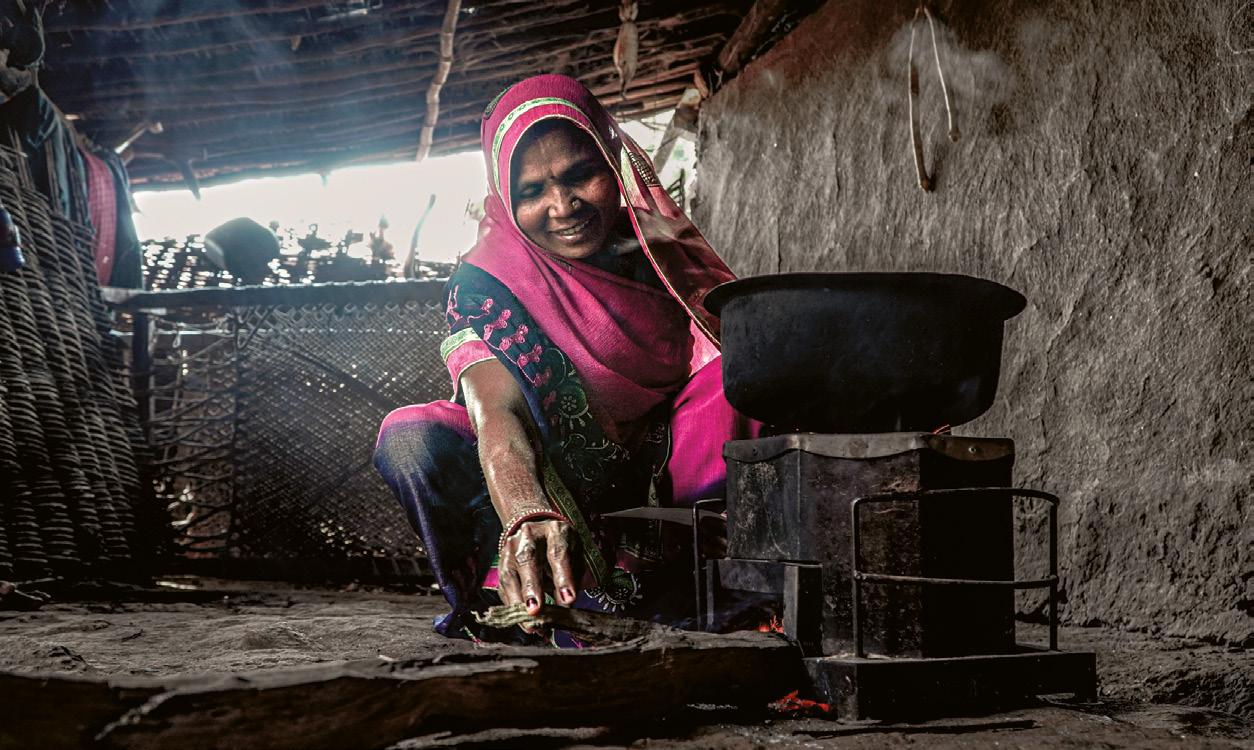
Partner with us to empower rural kitchens Make profitable gains from carbon credits while enabling strong climate action and community upliftment Corporations High-Net-Worth Individuals Private Equity / Venture Capitalists CSR Funds Good Investment Opportunity for: (+91) 731 42 89 086 business@enkingint.org www.enkingint.org EKI ENERGY SERVICES LIMITED One of the world’s largest carbon credits developer & supplier 40+ Countries | 3500+ Clients | 200+ Million Offsets Traded | BSE Listed also known as EnKing International Scan QR code to visit our website
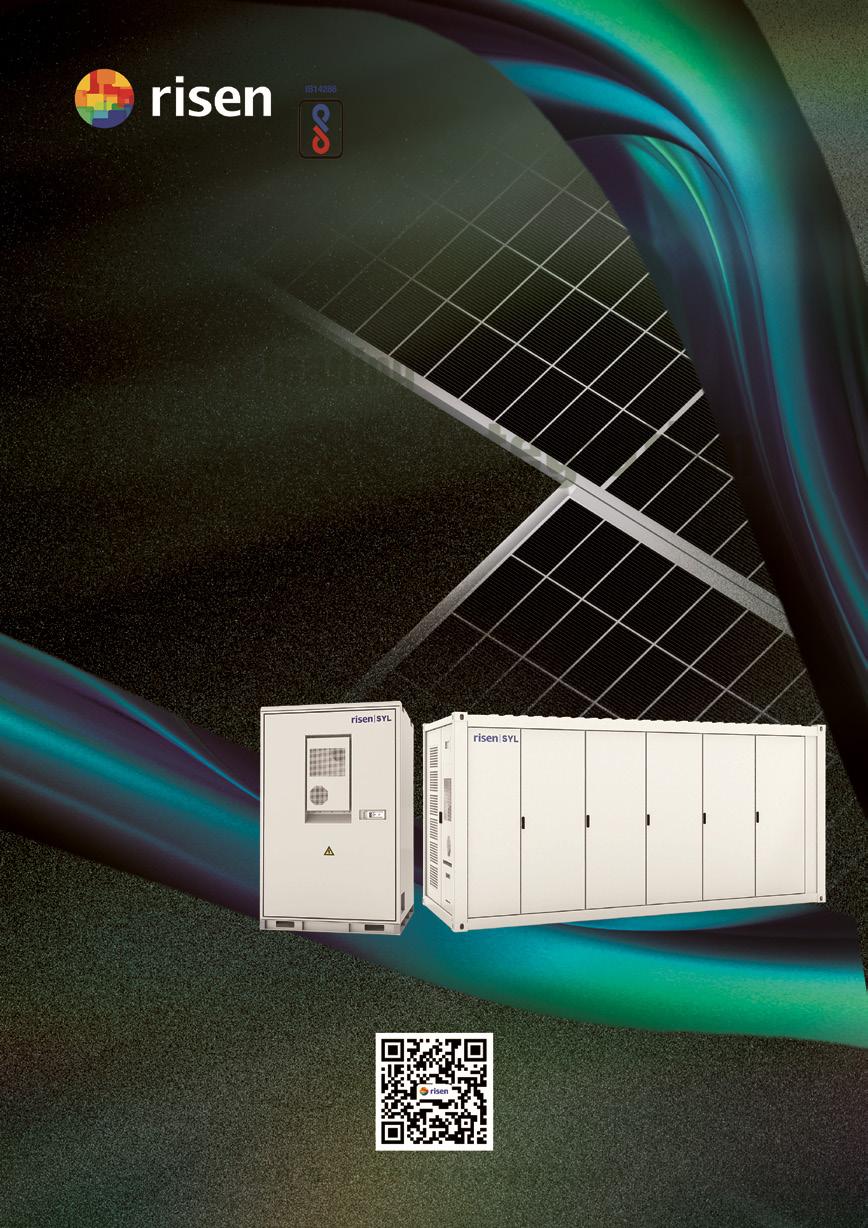



C O N T A C T U S w w w . r i s e n e n e r g y . c o m
VOLUME
INTERNATIONAL
OWNER : FirstSource Energy
India Private Limited
PLACE OF PUBLICATION : 95-C, Sampat Farms, 7th Cross Road, Bicholi Mardana Distt-Indore 452016, Madhya Pradesh, INDIA Tel. + 91 96441 22268 www.EQMagPro.com
EDITOR & CEO : ANAND GUPTA anand.gupta@EQmag.net
PUBLISHER : ANAND GUPTA
PRINTER : ANAND GUPTA
PUBLISHING COMPANY DIRECTORS: ANIL GUPTA
ANITA GUPTA
CONSULTING EDITOR : SURENDRA BAJPAI
HEAD SALES & MARKETING
MUKUL HARODE sales@EQmag.net
SR. GRAPHICS & LAYOUT DESIGNER : RATNESH JOSHI
GRAPHICS DESIGNER : ABHISHEK SARAI
SUBSCRIPTIONS : RISHABH CHOUHAN admin@eqmag.net
Disclaimer,Limitations of Liability
While every efforts has been made to ensure the high quality and accuracy of EQ international and all our authors research articles with the greatest of care and attention ,we make no warranty concerning its content,and the magazine is provided on an>> as is <<basis.EQ international contains advertising and third –party contents.EQ International is not liable for any third- party content or error,omission or inaccuracy in any advertising material ,nor is it responsible for the availability of external web sites or their contents
The data and information presented in this magazine is provided for informational purpose only.neither EQ INTERNATINAL ,Its affiliates,Information providers nor content providers shall have any liability for investment decisions based up on or the results obtained from the information provided. Nothing contained in this magazine should be construed as a recommendation to buy or sale any securities. The facts and opinions stated in this magazine do not constitute an offer on the part of EQ International for the sale or purchase of any securities, nor any such offer intended or implied
Restriction on use
The material in this magazine is protected by international copyright and trademark laws. You may not modify,copy,reproduce,republish,post,transmit, or distribute any part of the magazine in any way.you may only use material for your personall,Non-Commercial use, provided you keep intact all copyright and other proprietary notices. want to use material for any non-personel,non commercial purpose,you need written permission from EQ International.
FEATURED
SOLAX SIGNED A100 MW DISTRIBUTION AGREEMENT WITH SOLARIS TECHNO

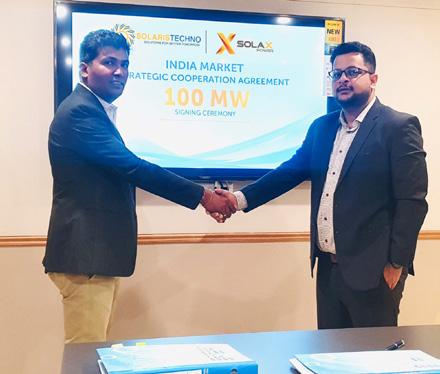
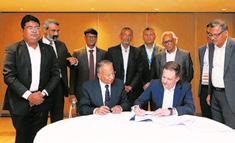
BUSINESS & FINANCE
VOLKSWAGEN PRESENTS NEW LOWPRICE ELECTRIC CAR, ID.2ALL
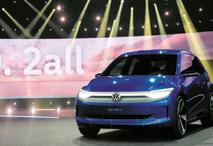
72
29 08
ENERGY STORAGE

BUSINESS & FINANCE
TATA POWER JOINS HANDS WITH ENEL GROUP TO POWER DIGITALISATION, AUTOMATION IN ELECTRICITY DISTRIBUTION
SMARTVILLE TAKES MAJOR STEP FORWARD WITH MOAB™, ITS SCALABLE, SECOND-LIFE ENERGY STORAGE SYSTEM INSTALLED FOR UC SAN DIEGO

TECHNOLOGY
Round Ribbon Technology in Gautam Solar’s 545 Wp 10BB Solar Panels
35
12
15 Issue 03 CONTENT
WEST BENGAL BUSINESSMAN MANOJIT MANDAL TURNS
OLA ELECTRIC TO RAISE $300 MN FOR EXPANSION PLANS TO MEET CORPORATE NEEDS
METRO TO REDUCE CARBON FOOTPRINT, HARNESS


STERLITE POWER SUCCESSFULLY COMMISSIONS ITS LARGEST GREEN ENERGY CORRIDOR PROJECT IN GUJARAT

ELECTRIQ POWER SECURES $300 MILLION FOR SOLAR+STORAGE FINANCING



ENI, ADNOC INK PACT TO COOPERATE IN RENEWABLES, HYDROGEN, CARBON CAPTURE
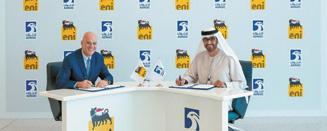
ELECTRIC VEHICLE

ELECTRIC VEHICLE INCENTIVE: GUIDELINES OUT FOR INTEREST-FREE ADVANCE TO ODISHA GOVT EMPLOYEES

CONTROLLING ELECTRIC DOUBLE LAYER DYNAMICS FOR NEXT GENERATION ALLSOLID-STATE BATTERIES
MR. GAUTAM MOHANKA

69 70 31 16 26 15 41 10 74
INDIA
EQ News
FEATURED FEATURED ENERGY STORAGE
INDIA Pg. 08-74
BUSINESS & FINANCE BUSINESS & FINANCE
INTERVIEW
SOLAR ENERGY FOR RAIL SYSTEMS
TATA NANO
INTO SOLAR CAR, DRIVES 100KM FOR JUST RS 30
Founded in 2005, JA Solar is a manufacturer of high-performance photovoltaic products. With 12 manufacturing bases and more than 20 branches around the world, the company’s business covers silicon wafers, cells, modules and photovoltaic power stations. JA Solar products are available in over 120 countries and regions.


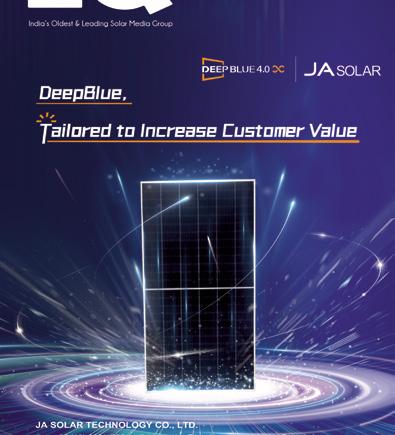





















www.renewx.in SOLAR ENERGY | DECENTRALISED RENEWABLE ENERGY | GREEN HYDROGEN | E-MOBILITY & ENERGY STORAGE | BIO ENERGY UNLOCKING
SUPPORTING NODAL AGENCY STATE PARTNER SUPPORTED BY PRODUCTS ON DISPLAY Photovoltaic Power Genera�on Systems Power Solu�ons for Residen�al / Socie�es Roo�op Solu�on Providers Solar as Solu�on for C&I consumers Intl Standard Solar Inverters / Hybrid Solu�ons Bi-Facial Modules High End Photo-voltaic (PV) Modules Energy Storage Solu�ons Electric Vehicles AMITAVA SARKAR M: +91 93792 29397 E: amitava.sarkar@informa.com JULIAN THOMAS M: +91 99404 59444 E: julian.thomas@informa.com IYER NARAYANAN M: +91 99673 53437 E: iyer.narayanan@informa.com FOR BOOKING, CONTACT AMIT SHARMA | M: +91 99109 55222 | E: amit.sharma@informa.com FOR SPEAKERSHIP OPPORTUNITIES PREMIUM PV JUNCTION BOX & CONNECTOR ONSITE BRANDING PARTNER ASSOCIATE PARTNER SOLAR MODULE & STORAGE PARTNER PREMIUM EXHIBIT PARTNERS
THE ERA TO NET ZERO EMISSIONS…
Introduction
To achieve cost reduction and efficiency increase in solar modules, multi-busbar technology has been adopted by manufacturers of photovoltaic crystalline silicon modules. Compared to the traditional five busbar modules which use flat ribbon connectors, multi-busbar modules use round ribbon connectors which helps in decreasing the electrical resistance loss and increases secondary utilization of light on the ribbon surface, thereby leading to increased power output of the modules. The use of multi-busbar technology in solar cells required a redesign of the cell pattern to replace the flat solder ribbons with round solder ribbons to minimize cell degradation due to internal stress. It also reduces the amount of silver needed for the front electrode ribbon by greater than 50%.
Round Ribbon Technology in Gautam Solar’s 545 Wp 10BB Solar Panels
Advantages of Round Ribbon Technology
Gautam Solar’s high efficiency 545 Wp 10BB Solar Panels incorporate Round Ribbon Technology to increase the performance of the panel and ensures its longevity so that the panel can work effectively for a period of 25+ years. The advantages offered by Round Ribbon Technology in Gautam Solar’s 545 Wp 10BB Solar Panels include:

•Lower Shading Losses
Compared to flat ribbon connectors that have width of 0.9mm, Round ribbon connectors have a diameter of 0.35mm.
Due to difference in shape and size, surface area of cell covered by round ribbon is much less than that covered by flat ribbon.
This leads to about 75% lower shading on cells and up to 2.5% power increase as compared with cells using flat ribbon.

8 EQ MARCH 2023 www.EQMagPro.com TECHNOLOGY
2. Higher light utilization
Flat ribbon provides low light utilization as most of the light falling on the ribbon is reflected back outside the module and only 5-10% light is reflected inside and converted to electricity.
On the other hand, in case of round ribbon, due to its shape, multiple internal reflection occurs and most of the light falling on the ribbon is reflected. Some of the reflected light escapes the module but overall, nearly 70% light is converted to electricity.
In flat ribbon, the current density drop is around 0.9 mA/cm2, whereas in case of round ribbon, the current density drop is just 0.4 mA/cm2. As a result, more current and hence more power is generated.

Apart from this, power generated from light striking at oblique incidence is also intensified.
Conclusion
Hence, it can be seen that the application of round ribbon interconnectors with multi-busbar technology is beneficial for increasing not only the power and efficiency of the cell, but also its durability. For using round ribbon technology in 545 Wp 10BB Solar Panels, only the inkjet mask and screens for screen printing process have to be adapted (which represents a small investment). Despite this, the major limitation in implementation of this technology for manufacturers is the high investment in a different kind of cell stringer called Multi Busbar Cell Soldering Stringer. Though the initial investment is higher, it pays off in the long term as the performance of the solar panels increases which leads to greater customer satisfaction.
Using Round Ribbon for Lower Shading on Cells


www.EQMagPro.com 9 EQ MARCH 2023
TECHNOLOGY
MR. GAUTAM MOHANKA CEO & MANAGING DIRECTOR Gautam Solar Private Limited

EQ: Which are the advanced technologies that have been adopted in your products and processes?

GM: Gautam Solar is a reputed Solar Module Manufacturing company with 25+ Years of experience. With a strong R&D unit, our company is known for taking out cutting edge solutions for the solar industry and our numerous IPs (Designs & Patents) is a testament to our commitment to innovation. In terms of Product, our 545 Wp Monocrystalline PERC Solar Modules adopt advanced technologies like bigger M10 cells for higher power generation, multibusbar technology for lower electrical losses, round ribbon connectors for better light utilization, bifacial PERC technology for power generation from both sides, non-destructive laser-based cell cutting for higher reliability and lower chances of micro-cracks and half-cut cell technology for better low-light performance. Speaking of Processes, our modules are manufactured using First-Hand Topline Machines and undergo rigorous testing and certifications, making us one of the few solar module manufacturers in India with BIS & ALMM Approved Solar Panels.
EQ: What are your growth and expansion plans for the next couple of years?
GM: Our current solar module manufacturing capacity is 400 MW and we’re planning to expand to a total of 1 GW capacity by FY2024. 250 MW of capacity addition will be through the expansion of capacity of our Haridwar plant while we’re looking for locations near a seaport in Gujarat for 350 MW Capacity addition. We’re looking to invest nearly 100 crores for this expansion, which does not include the cost of the land. The recent policy initiatives by the government such as ALMM and BCD have given a much-needed thrust to the domestic solar manufacturing sector, to make our products more cost-competitive with China-based manufacturers.
EQ: What kinds of challenges the present geopolitical situation has posed in terms of the Dynamics of Price - Demand - Supply for this year and the near future?
GM: The geopolitical situation has created several challenges in terms of the Dynamics of Price – Demand – Supply for the near future. Some of these challenges include limited access to resources including raw materials for solar panels, trade barriers which have had a negative impact on imports, hesitancy in investment, lack of cooperation among nations, diverted attention from green economy, security concerns and lack of international support. It's important to note that the situation is complex and multifaceted, and we are hopeful that world leaders will try to work together to address the geopolitical situation so that progress can be made towards a cleaner and greener earth.
EQ: Whats your views on the ALMM?
GM: The ALMM has become a key resource for individual “customers and developers” looking to procure solar PV Panels in the country as it only includes panels that meet strict standards set by the Ministry of New and Renewable Energy (MNRE). Gautam Solar has 4 state of the art manufacturing facilities in Haridwar, Uttrakhand for manufacturing of solar modules which ensured that our 545 Wp Series of 10BB Mono PERC Panels were enlisted in ALMM.
EQ: As compared to western markets, interest rates in domestic solar energy markets are much higher. What should be done to reduce interest rates?
GM: The domestic solar energy market’s interest rates are 8-10%, whereas the same for western markets is only 3-4%. It is a big challenge in the growth of Indian solar energy sector. There are several steps that can be taken to reduce interest rates in the domestic solar energy market in India including government support to lenders and investors, risk reduction through strong regulatory and policy framework, standardization of documentation, capacity building of local banks and institutions for low-cost finance. Also increased competition from new industry players will drive down interest rates.
10 EQ MARCH 2023 www.EQMagPro.com INTERVIEW
DRY ROBOTIC CLEANING, A PRACTICAL WAY TO SAVE WATER RESOURCES


March 22nd is World Water Day. According to the calculation, cleaning a 10MW power plant once requires 100 tons of water by flushing PV modules with water trucks, or 50 tons of water by cleaning with a water brush.
By the end of 2022, the Global cumulative PV capacity is 1208 GW. If calculated by cleaning 4 times per year, the annual water consumption will be 24,160,00 tons. PV cleaning by water needs to be regulated. India, which is facing high water stress, is even more stringent on the water usage for PV plants. India's MNRE requires that solar panels should be cleaned with as less water as possible and encourages the use of intelligent PV cleaning robots. Under these circumstances, Sunpure has developed dry cleaning robots for PV modules with the advantages of higher efficiency, higher quality and higher frequency of cleaning, and applied them to several large-scale PV power plants. Protecting water resources, Sunpure is always taking practical action.

INTERVIEW
SOLAX SIGNED A100 MW DISTRIBUTION AGREEMENT WITH SOLARIS TECHNO

With the aim of working together to create a cleaner and more sustainable future for all, SolaX Power, one of the well-known PV inverter suppliers in the world, has signed a 100 MW distribution agreement with Solaris Techno, a prominent distributor in India.
On March 2,SolaXsigned a distribution agreement with Solaris Techno to provide 100 MW of residential and C&I inverters to the Indian market.This cooperation is a win-win for both SolaX and Solaris Techno since they can leverage their respective strengths tomake greater achievements. Solaris Technohas a vast network and expertise in the distribution of photovoltaic products, which will enable SolaX’s solar inverters to be accessible to consumers across India, providing them with affordable and sustainable energy solutions.Solaris Techno endeavors to provide prompt and thorough service to its customers and selects its partners with great care to provide top-class solar products. SolaX has won the trust of Solaris Techno due to its advanced and comprehensive portfolio of on-grid inverters, hybrid inverters, batteries and EV-Charger; covering all kinds of application scenarios, including residential andC&I sectors.This extensive product range positions SolaX as an attractive partner for Solaris Techno, providing custom
as an attractive partner for Solaris Techno, providing customers with a one-stop-shop for their renewable energy needs. The partnership with Solaris Techno is a significant achievement for SolaX, which has been steadily expanding its global reach in recent years. SolaX will do its utmost to meet India’s increasing demand for PV products and contribute to the government’s ambitious goal of reducing carbon emissions. As a company committed to powering a green future, SolaX will keep pushing forward with renewable energy technologies in the future, providing innovative solutions to meet the evolving needs of its clients.
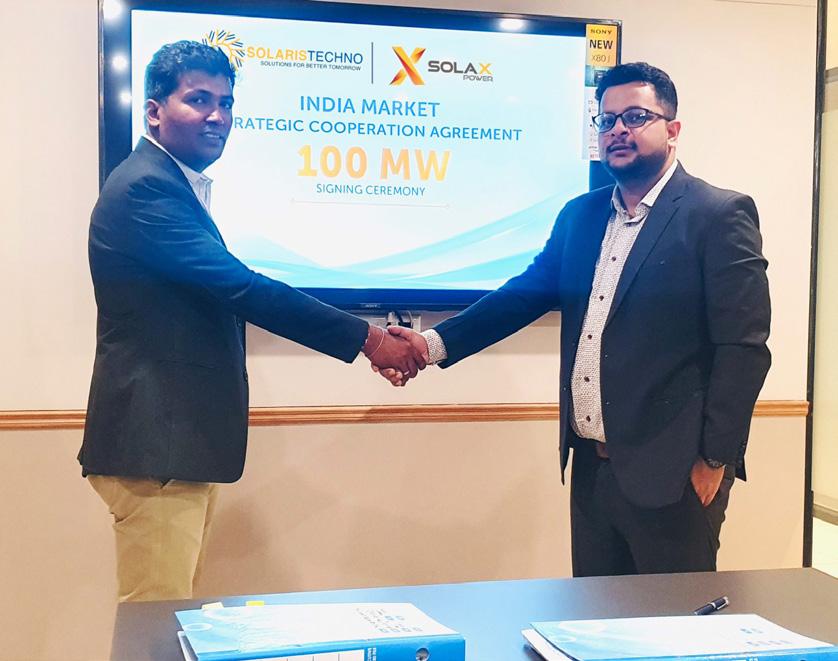
12 EQ MARCH 2023 www.EQMagPro.com FEATURED
GLOBAL ENERGY-RELATED CO2 EMISSIONS EDGED UP TO RECORD HIGH IN 2022 – IEA
Global energy-related emissions of carbon dioxide hit a record high last year, although more clean technology such as solar power and electric vehicles helped limit the impact of increased coal and oil use, the International Energy Agency (IEA) said
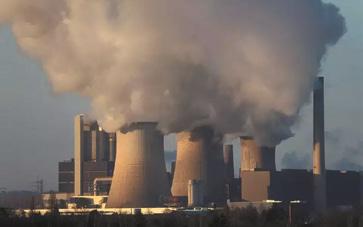
Deep cuts in emissions, mainly from burning fossil fuels, will be needed over the coming years if targets to limit a global rise in temperatures and prevent runaway climate change are to be met, scientists have said.
“We still see emissions growing from fossil fuels, hindering efforts to meet the world’s climate targets,” IEA Executive Director Fatih Birol

The report by the Paris-based watchdog comes just weeks after major fossil fuel producers such as Chevron (CVX.N), Exxon Mobil (XOM.N) and Shell (SHEL.L) reported record profits,
with BP BP.L also rowing back on plans to slash oil and gas output and reduce emissions. “International and national fossil fuel companies are making record revenues and need to take their share of responsibility,” Birol said. Global emissions from energy rose by 0.9% in 2022 to a record 36.8 billion tonnes, the IEA analysis showed. Carbon dioxide (CO2) emissions from coal grew by 1.6% last year with many countries turning to the more polluting fuel after Russia’s invasion of Ukraine and a reduction in Russian gas supply to Europe sparked record high gas prices. CO2 emissions from oil rose by 2.5% but remained below pre-pandemic levels the report said. Around half of the increase in oil-related emissions was due to a rise in air travel which was rebounding from a low during the pandemic. Lower output from nuclear power plants and extreme weather events including heatwaves also contributed to the increase in energy related emissions, the IEA said. Emissions were partly offset, however, by a rise in renewable power sources like wind and solar, energy efficiency measures and electric vehicles. These avoided an additional 550 million tonnes of CO2 emissions last year, the IEA said.
Source: Reuters
THERMAX ENTERS THE GREEN HYDROGEN MARKET IN PARTNERSHIP WITH FORTESCUE FUTURE INDUSTRIES

Thermax Limited, a leading energy and environment solutions provider, and Fortescue Future Industries (FFI), an Australia-based green energy and green technologycompany,have signed a Memorandum of Understanding (MoU) to exploregreen hydrogen projects – including new manufacturing facilities – in India.

Under the MoU, Thermax and FFI plan to explore opportunities tojointly develop fully integrated green hydrogen projects for commercial and industrial customers in India. The production of green hydrogen at an industrial scale would be a major step forward in decarbonising hard-to-abate industries in India, such as refineries, fertilisers and steel. The MoU between Thermax and FFI also contemplates the potential collaboration of the parties in the development of new manufacturing facilities to support green energy projects in India. The Performance Linked Incentive (PLI scheme), under India’s National Green Hydrogen Mission,could be leveraged for setting up any new manufacturing capacity. In addition to meeting the domestic requirements, electrolysers and subsystems could potentiallybe used for export internationally. Fortescue Metals Group’s experience in managing large-scale projects in its iron ore business provides FFI – Fortescue’s green energy arm – with a strong platform to expand into manufacturing projects in green hydrogen. FFI is in the process of constructing a world-leading Green Energy Manufacturing Centre in Gladstone, Queensland. The first phase of the project involves the construction of an electrolyser manufacturing facility, with a targeted initial output capacity of 2GW per annum. Thermax will bring its vast experience in EPC and supplychain to the collaboration.
Expressing his thoughts on the collaboration, Ashish Bhandari, MD & CEO, Thermax, “The collaboration with Fortescue Future Industries is perfectly timed to leverage the massive potential of the Indian green energy market that presents a multitude of opportunities, backed by favourable policies and incentives. Furthermore, the recent approval of the National Green Hydrogen Mission by India’s Union Cabinet, which aims to increase domestic production of green hydrogen to 5 MMT per annum by 2030 and reduce fossil fuel imports by over Rs. 1 lakh crore, is a significant boost. With all these factors working in our favour, we are confident that our association will be successful.”
FFI CEO Mark Hutchinson said, “FFI is on a mission to replace fossil fuels by producing green electrons from renewable energy and then converting these green electrons into green hydrogen. Through the National Green Hydrogen Mission, the Indian Government has shown that it is committed to developing its green hydrogen industry to help the country decarbonise. We are thrilled to be working with Thermax andbelieve that this MOU with a company of such high standing will help us in our mission to eliminate emissions.”
www.EQMagPro.com 13 EQ MARCH 2023 FEATURED
India’s power consumption surged 10 per cent to 1375.57 billion units (BU) during April-February this fiscal year, and has already surpassed the level of electricity supplied in entire 2021-22. The government data showed that power consumption in April-February 2021-22 was 1245.54 BU. Experts say power consumption is expected to grow in double digits in the coming months in view of forecasts of unprecedented high demand, especially in summer. The power ministry has estimated peak power demand in the country at 229 GW during April this year, which is higher than 215.88 GW recorded in the same month a year ago. The ministry has taken many steps to meet high power demand and also asked state utilities to not go for power cuts or load shedding.

The ministry has also asked all imported coal-based power plants to run on full capacity from March 16, 2023, to June 15, 2023. Besides, it has asked other thermal power generators to import coal for blending with domestic dry fuel. Experts say higher economic activities would boost commercial and industrial demand in the coming months. Besides, they opined that scorching heat during summer would result in higher consumption of power for running air conditioners and other cooling appliances. They are of the view that it would be a challenge to meet unprecedented high demand of electricity in India April onwards.
‘WIND ENERGY PROJECTS GENERATED 64.54BN ELECTRICITY UNITS IN APRILJAN OF FY23’
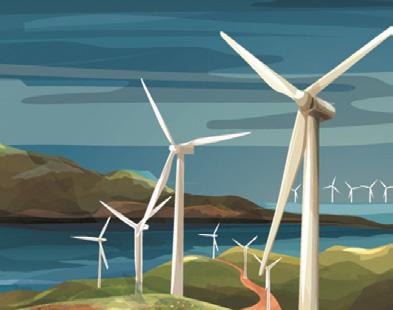
The electricity produced from wind energy projects was 64.54 billion units during the April-January period of 202223, according to the Ministry of New and Renewable Energy data. Tamil Nadu and Gujarat are the two states which lead in terms of generating electricity through wind energy. During April 2022-January 2023, Gujarat produced 17,062 million units of electricity from wind energy power projects. Tamil Nadu was the second highest generator of electricity from wind energy power projects, as it generated 15,703 million units of electricity during the period under review.
The government has taken several measures for promoting wind energy, like declaration of trajectory for wind renewable purchase obligation – Wind RPO – up to 2030. In addition to this, the government has announced concessional Customs duty exemption on certain components required for manufacturing of wind electric generators. Generation-based incentive is being provided to the wind projects commissioned on or before March 31, 2017. The overall energy storage capacity developed in the country as on March 13, 2023 is 4,745.60 MW from Hydro Pumped Storage Projects and 39.12 MWh from Battery Energy Storage System. However, this energy storage capacity is not specific to any particular technology, official sources said.
Source: PTI Source: PTI
14 EQ MARCH 2023 www.EQMagPro.com INDIA
INDIA’S POWER CONSUMPTION RISES 10% IN APR-FEB TO 1375 BILLION UNITS, CROSSES FULL FISCAL ENERGY SUPPLIES A YEAR AGO
In entire fiscal year 2021-22, power consumption was 1374.02 BU, which is less than 1375.57 BU recorded during April 2022 to February 2023 period.
Tamil Nadu was the second highest generator of electricity from wind energy power projects, as it generated 15,703 million units of electricity during the period under review
METRO TO REDUCE CARBON
FOOTPRINT, HARNESS SOLAR ENERGY FOR RAIL SYSTEMS

Harnessing of solar energy, mandatory green building certification in detailed project reports (DPRs), and energy-efficient design to ensure natural lighting and ventilation are among several recommendations made by the ministry of housing and urban affairs (MoHUA) to reduce carbon footprints and cost of metro rail systems. These suggestions are part of the draft report on ‘Standardisation/Indigenisation of Electrical & Electromechanical Metro Rail Components’ circulated recently among all stakeholders including state authorities and other agencies to seek their feedback and inputs.Following review of comments or feedback from the stakeholders, the specifications will be finalised.
“Metro rail systems use electrical energy extensively. To reduce carbon footprints, harnessing solar energy to meet energy requirements should be explored. In a typical metro system, solar rooftop photo voltaic (SPV) power plant can be installed on station roofs, depot roof/ sheds, office buildings, parking areas, sub-station buildings, and staff quarters etc,” read an annexure to the report.
The report further suggests that interconnection or interchange of underground and elevated station area may be provided with natural lighting and ventilation or if required, high volume low speed large fans may be used in place of conventional air-conditioning.
“Already metro stations are being certified by the IGBC (Indian Green Building Council) as green buildings. Further, obtaining green building certification can be kept as an essential requirement in DPR,” states the draft. ‘Standard Specifications’ aim to bring uniformity in components being used in different systems in metro rail operations including power supply, traction, tunnel ventilation, air-conditioning, fire alarm,elevators, noise control, and air filtration.
In 2022-23, it was announced that design of metro systems including civil structures, will be reoriented and standardised for Indian conditions and needs. In view of the announcement, the ministry decided to revise the standard specifications of various metro rail components. Hence the draft report has been prepared after detailed and extensive deliberations. The original standard specifications were issued in August 2018.
Source: PTI
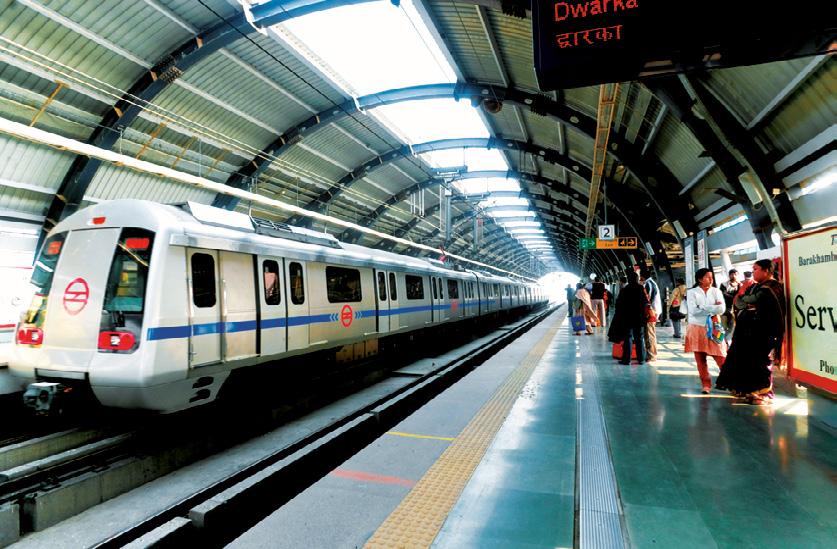
www.EQMagPro.com 15 EQ MARCH 2023 INDIA
In 2022-23, it was announced that design of metro systems including civil structures, will be reoriented and standardised for Indian conditions and needs.
The running cost of the car will shock everyone. This petrol-free “solar car” runs 100 kilometres for just Rs. 30 to 35. It has now become a mechanical icon of Bankura. Common people are curently getting perplexed by the price of petrol and diesel. Manojit Mandal of Bankura has shown direction by making a solarpowered car. The cost per kilometre is 80 paisa. As there is no engine, there is no sound even when the car is started. However, there is a gear system. This wonder car can run at a speed of 80 km per hour in fourth gear almost silently.
WEST BENGAL BUSINESSMAN MANOJIT MANDAL TURNS TATA
NANO INTO SOLAR CAR, DRIVES 100KM FOR JUST RS 30

Manojit Mandal wanted to make something new since childhood. So, he built a solar car for himself without complaining about the increase in petrol prices. Manojit faced many challenges while converting the car. Although this sensational car has not left a mark in the mind of the government, there has been no response from the government. However, it is undeniable that Manojit Mandal of Bankura district is the pioneer in solving the problem of limited fossil fuels.
Source: PTI
CABINET NOD FOR LISTING OF RENEWABLE ENERGY MINI-RATNA IREDA
The government approved the listing of IREDA, a CPSE under the Ministry of New & Renewable Energy (MNRE) on the stock exchanges through an initial public offer (IPO) by the part sale of the government’s stake in it to raise funds. The government said the instant decision has been necessitated due to change in capital structure following the infusion of capital to the tune of Rs 1,500 crore by the government in March 2022. “This decision supersedes earlier CCEA decision taken in June 2017 for allowing IREDA (Indian Renewable Energy Development Agency) to issue 13.90 crore fresh equity shares of Rs 10.00 each to the public on book building basis through IPO,” reads the press note.
Now, the Department of Investment and Public Asset Management (DIPAM) will drive the listing process. “The IPO will help in unlocking the value of government’s investment on the one hand and on the other will provide an opportunity to the public to acquire a stake in the national asset and draw benefits therefrom,” reads the press note. Besides, it will help IREDA in raising a part of its capital requirement for meeting growth plans without depending on the public exchequer, and improve governance through greater market discipline and transparency arising from listing requirements and disclosures.
IREDA is currently wholly owned Government of India, Mini-Ratna. In another decision, the Cabinet Committee on Economic Affairs granted an exemption to NTPC from the extant guidelines of delegation of power to Maharatna CPSEs for making an investment in NTPC Green Energy Limited (NGEL), a Subsidiary Company of NTPC Ltd. The cabinet also exempted NGEL’s investment in NTPC Renewable Energy Limited (NREL) and its other JVs/subsidiaries subject to a ceiling of 15% of its net worth beyond the monetary ceiling of Rs 5,000 crore to Rs. 7,500 crores, towards achieving a target of 60 GW Renewable Energy (RE) Capacity by NTPC. NTPC, through this investment in the RE sector, aims to add 60 GW of Renewable Energy Capacity by 2032 which will help the Country to achieve Net Zero emissions by 2070.
Source: PTI
16 EQ MARCH 2023 www.EQMagPro.com INDIA
Manojit Mondal, a resident of Katjuridanga, Bankura drives a solar-powered car. Manojit, a businessman by profession, drives around the streets of Bankura by converting a nano car into a solar car. This car does not require any petrol at all. Also, it does not run on an engine.
The government said the instant decision has been necessitated due to change in capital structure following infusion of capital to the tune of Rs 1,500 crore by the government in March 2022.
TN GOVT TO SET UP 15 NEW POWER PROJECTS WITH 14,500 MW CAPACITY
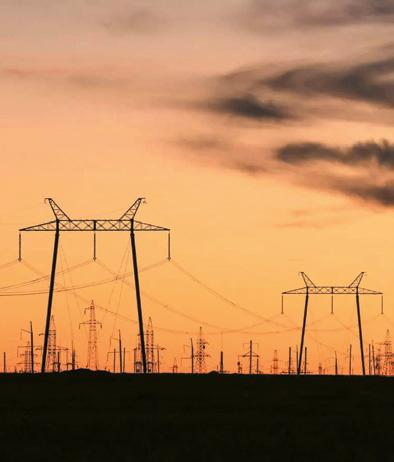
The Tamil Nadu government will establish 15 new power projects under the PPP mode with a total capacity of 14,500 MW at an estimated cost of Rs.77,000 crore by 2030. The Government will also bring out a comprehensive policy to promote investment in pumped hydroelectric storage in the State, Finance Minister PTR Palanivel Thiagarajan announced in the State Assembly, while presenting the budget for the year 2023-24, today.


Minister said with the objective of fulfilling the increasing demand for power in the State, the Government intends to double the installed capacity for power generation in the State by adding 33,000 MW by 2030, giving high priority to development of renewable energy sources. The present contribution of green energy to the State grid at 20.88 per cent is proposed to be increased to 50 per cent by 2030 through additional capacity creation. With solar energy potential of 20 GW, onshore wind energy potential of 70 GW and offshore wind energy potential of 30 GW, Tamil Nadu has immense renewable energy resources and opportunities, he said.
To transform Tamil Nadu into a green power house with more than 50 per cent of power generation from renewable sources by the year 2030, the Government will create a dedicated Special Purpose Vehicle”, he said, adding, further, a new policy on repowering windmills in the State will be evolved. Mr Palanivel Thiagarajan also said pumped storage hydroelectric projects will be established under PPP mode to meet the peak hour power demand in the State.
He said the 500 MW pumped hydroelectric storage project being constructed at Kundah will be operational by 202425. “Further, 15 more projects will be established under the PPP mode with a total capacity of 14,500 MW at an estimated cost of Rs.77,000 crore by 2030”, headdded. He also said the on-going thermal power projects of 4100 MW will be completed expeditiously. To automate fetching of metered data, a smart metering system will be installed with prepaid functionality for all paid consumer connections under the RDSS scheme. As a result of the structural and systemic reforms undertaken by the Government, the fiscal position of TANGEDCO has improved slightly and it is expected that the loss of TANGEDCO will be reduced to Rs.7,825 crore in 2022-23 from Rs.11,955 crore in 2021-22.
He said the 500 MW pumped hydroelectric storage project being constructed at Kundah will be operational by 2024-25.”Further, 15 more projects will be established under the PPP mode with a total capacity of 14,500 MW at an estimated cost of Rs.77,000 crore by 2030″, headdded. He also said the on-going thermal power projects of 4100 MW will be completed expeditiously. To automate fetching of metered data, a smart metering system will be installed with prepaid functionality for all paid consumer connections under the RDSS scheme.
As a result of the structural and systemic reforms undertaken by the Government, the fiscal position of TANGEDCO has improved slightly and it is expected that the loss of TANGEDCO will be reduced to Rs.7,825 crore in 2022-23 from Rs.11,955 crore in 2021-22. An allocation of Rs.14,063 crore has been provided in the Budget Estimates towards various subsidies provided to TANGEDCO, he said.
www.EQMagPro.com 17 EQ MARCH 2023 INDIA
INDIA’S ELECTRICITY CONSUMPTION GROWS OVER 9 PC TO 117.84 BILLION UNITS IN FEBRUARY

Experts say power consumption and demand are expected to increase due to heatwave forecasts during this summer India’s power consumption logged a year-on-year growth of over 9% to 117.84 billion units in February this year, according to government data. The robust growth of power consumption indicates sustained momentum of economic activities in February. Experts had earlier said that power consumption and demand would register a substantial increase in March due to further improvement in economic activities as well as rise in temperature. In February 2022, power consumption stood at 108.03 billion units (BU), higher than the 103.25 BU in the same month of 2021, the data showed. The peak power demand met, which is the highest supply in a day, rose to 209.66 gigawatt (GW) in February 2023. The peak power supply stood at 193.58 GW in February 2022 and 187.97 GW in February 2021. The peak power demand met was 176.38 GW in the pre-pandemic February 2020. Experts are of the view that power consumption and demand would log higher growth rates in the coming months due to forecasts of higher temperature during this summer season compared to last year.
TRIVENI GLASS SHARES JUMP UPPER CIRCUIT 5% ON ANDHRA PRADESH SOLAR GLASS FACTORY NEWS
Shares of Triveni Glass had closed in its 5% upper circuit at Rs 22.60 on February 28 following a news report that the glassmaker would invest Rs 1,000 crore to set up an 840-tonneper-day solar glass manufacturing plant in Andhra Pradesh. The stock has rallied 555% over the past three years to a 52-week high of Rs 30.9 and was trading at Rs 22.6 on the morning of February 28. News reports said the company would set up the plant at Pangidi in the East Godavari district, creating 2,000 jobs. It added that Varun Gupta, managing director of Triveni Glass, met Chief Minister YS Jagan Mohan Reddy on February 27 and discussed investments in the state, which is on the verge of holding the Global Investors Summit in Visakhapatnam on March 3 and 4. News reports say Reddy pledged to cooperate fully with Triveni Glass and told Gupta that the state offers good human resources and other facilities. Triveni Glass’ stand-alone revenue rose to Rs 1.6 crore in the December quarter from Rs 0.07 crore a year earlier, while a net profit of Rs 1.13 crore against a net loss of Rs 0.1 crore.

18 EQ MARCH 2023 www.EQMagPro.com INDIA
Source: PTI
FC TECNRGY, SFC ENERGY INK PACT FOR HYDROGEN, METHANOL FUEL CELL UNIT IN GURUGRAM


TecNrgy and German firm SFC Energy have inked a pact for hydrogen and methanol fuel cell manufacturing in India with a plan of new facility in Gurugram, Haryana. As per the pact, SFC will manufacture its EFOY hydrogen and EFOY methanol fuel cells locally and take care of quality assurance while FCTec will continue to be the ‘go to market’ partner that will include identifying opportunities, engineering & assembly of customized fuel cell solutions, system integration besides design and development of other critical components for such solutions and after-sales service.
Peter Podessor, CEO of SFC said the step to open a location in India is logical and a part of SFC’s medium-term strategy. With this new presence, it wants to further expand its Asian business with India as a core market.

“Manufacturing of the entire solution including fuel cells in India is part of our longterm strategy which will position us as one of the market leaders in this segment of fuel cells in India,” said Colonel Karandeep Singh (Retired), the founding director of FCTec

The agreement was officially signed off during the India visit of German Chancellor Olaf Scholz. FCTec is a leading Indian fuel cell engineering & and system integrator of methanol and hydrogen fuel cells for stationary and mobile hybrid power solutions.
LOI SIGNED BETWEEN DST & FRAUNHOFER ISE ON HYDROGEN & CLEAN ENERGY TECHNOLOGIES CAN ACCELERATE ENERGY TRANSITION IN INDIA
ALetter of Intent (LoI) was signed between the Department of Science and Technology (DST) and Fraunhofer Institute for Solar Energy Systems (Fraunhofer ISE) for a long-term collaboration focusing on hydrogen technologies. The LoI was signed on 25th February, 2023, by Dr. Anita Gupta, Scientist G and Head, Energy Technologies Cell, DST and Prof. Dr. Christopher Hebling, Director, Division Hydrogen Technologies, Fraunhofer ISE in the presence of Secretary, DST, Dr. S. Chandrasekhar. The event was also attended by Mr. R. Madhan, Director, Indo-German Science & Technology Centre (IGSTC), Ms Anandi Iyer, Director Fraunhofer India and officials representing both the sides. India and Germany share the goal of decarbonizing their economies and are committed to collaborating jointly in the pursuit of energy security and climate protection. Both countries have committed to develop a national green hydrogen economy to
Source: PTI
facilitate achievement of the Paris Agreement targets. The LoI will trigger development of higher Technology Readiness Level (TRL) for hydrogen energy clusters being set up by DST and identify existing technologies and potential interventions from Fraunhofer in green hydrogen, integrate them with indigenous technologies, and deploy /calibrate them for Indian conditions. DST will provide the enabling framework for cooperation in the hydrogen valley cluster projects, support activities, and facilitate the resources needed wherever applicable and possible. Meanwhile Fraunhofer acts as a technology partner for the hydrogen valley /cluster, provides information and access to technologies of TRL 5 – 8, scientific and technical experts, collaboration in preparing technology roadmaps and guidelines for innovation ecosystem/cluster. This collaboration will pave the way to forge active engagements and collaborations based on mutual needs and strength to further research and technological capabilities in the hydrogen and clean energy sector. It would help in accelerating pathways for energy transition in India.
www.EQMagPro.com 19 EQ MARCH 2023
INDIA
INDIA CALLS FOR GREATER COOPERATION WITH FRANCE IN THE FIELD OF CLEAN ENERGY AND HIGHLIGHTED NEW
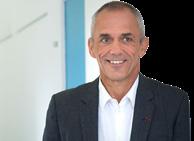

DELHI’S PLANS FOR GREEN TRANSITIONING TO EVS AND HYDROGEN ENERGY
Dr. S. Chandrasekhar, Secretary, Ministry of Science and TechnolGoI inaugurates the Indo-French Workshop on Clean and Sustainable Energy Technologies (INFINITE) at CSIR – National Physical Laboratory in New Delhi Using the Thar Desert as a site for solar power generation, India is estimated to generate up to 2,100 GW of solar energy: Dr S Chandrasekhar Partnership with France and other G20 countries are required for green energy generation, storage and conversion, particularly green hydrogen, green ammonia, and energy storage infrastructures: Dr. N. Kalaiselvi
India calls for greater cooperation with France in the field of clean energy and highlighted New Delhi’s plans for green transitioning to EVs and hydrogen energy. Indian renewable sector ranks 4th on the list of the world’s most attractive renewable energy sectors and Solar energy is the most abundant source of renewable power in the country. Inaugurating the Indo-French Workshop on Clean and Sustainable Energy Technologies (INFINITE) at CSIR – National Physical Laboratory in New Delhi, Dr. S. Chandrasekhar, Secretary, Ministry of Science and Technology, Government of India said that the Government in 2022 had set a target of installing 100 GW of solar energy. He added that using the Thar Desert as a site for solar power generation, India is estimated to generate up to 2,100 GW of solar energy.
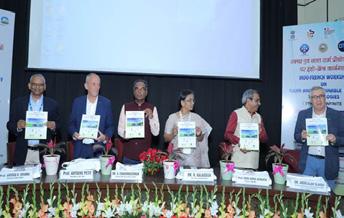

saline aquifers, basalts, etc. He said, the government has designed policies, programs, and a liberal environment to attract foreign investments to ramp up the country in the renewable energy market at a rapid rate. Department of Science and Technology is also interested in encouraging international collaborations on clean energy research. “I hope the process and technologies that will be discussed in this workshop will be of enormous potential in mitigating the impact of climate change and reducing greenhouse gas emissions”, Secretary added.
Dr Chandrasekhar referred to another initiative of the Govt. of India and that is the National Biofuel Policy, which aims to achieve a 20% blending of ethanol in petrol and a 5% blending of biodiesel in diesel by 2030. Dr Chandrasekhar pointed out that an area to focus upon is Carbon Capture and Storage and as estimated by NITI Aayog, theoretically, India has a total geological CO2 storage capacity of 400-600 Gt considering the depleted oil and gas reservoirs, un-mineable coal seams,

In her address, Dr. N. Kalaiselvi Director General, CSIR and Secretary DSIR, said that India needs huge augmentation in the manufacturing of renewable energy technologies and infrastructures. She underlined that partnership with France and other G20 countries are required for green energy generation, storage and conversion, particularly green hydrogen, green ammonia, and energy storage infrastructures. India and France have long standing bilateral research co-operation specially to augment research on clean and renewable energies, she added.
Pr. Antoine Petit, CEO of the French National Centre for Scientific Research (CNRS) expressed appreciation for the strong partnership between the two countries and emphasized the importance of collaboration in achieving a sustainable energy transition through new bilateral programs.
20 EQ MARCH 2023 www.EQMagPro.com INDIA
Prof. Arvind Kumar Mishra, Director CSIRCIMFR pointed out that this workshop is broadly focused to bring together academic and industrial experts from France and India to develop collaborations in the area of clean and sustainable energy. He said, both the sides need to identify specific research problems and objectives, and identify partners to develop new knowledge bases, joint IPs, and tangible outcomes in biomass energy, coal to methanol/ clean fuels, solar energy, hydrogen, energy storage, and carbon capture utilization and storage. We need to share our experiences, explore new ideas, and challenge ourselves to think differently.


and Fuel Research (CIMFR), Dhanbad, and the French National Centre for Scientific Research (CNRS), France and is being supported by the Indo-French Centre for the Promotion of Advanced Research (CEFIPRA).

Prof. Venugopal Achanta, Director, CSIR – NPL welcomed the guests, invitees, and delegates, and Prof. Arvind K. Mishra, Director, CSIR – CIMFR made the opening remarks.
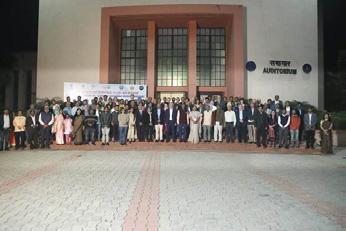
Prior to the workshop, the bilateral meeting between DG, CSIR, and the CEO of CNRS also included discussions on strengthening cooperation in the field of clean energy research and development and formulation of new R&D programs between the two countries. The meeting was also graced by Directors of several CSIR Labs and other French Representatives from CEFIPRA, CNRS, CEA, and the Embassy of France in India, New Delhi.
The objective of the workshop is to bring together experts, researchers, policymakers, and industry leaders from both countries to exchange knowledge, ideas, and best practices on the development and deployment of clean and sustainable energy technologies. The workshop will feature a range of presentations and discussions on various topics related to Solar Energy, Hydrogen Energy, Carbon Capture Utilization & Storage, Electrochemical Energy Storage, and Clean Fuels. The event has been jointly organized by CSIR – Central Institute of Mining
The INFINITE workshop provides a platform for experts and stakeholders from both countries to exchange knowledge, identify areas of collaboration, and explore new avenues for cooperation in the field of clean and sustainable energy technologies. The event is expected to be successful, and it is hoped that the discussions and collaborations initiated during the workshop will lead to concrete outcomes in the near future. The bilateral workshop is being coordinated by Dr. R. Ebhin Masto, Senior Principal Scientist, CSIR – CIMFR, India, and Dr. Abdelilah Slaoui, Deputy Research Director In-Charge of Energy, CNRS, France.
GOA CAPITAL TO ACHIEVE ‘SOLAR CITY’ GOAL: CM SAWANT
To achieve sustainable development goals, the government has decided to declare capital city Panaji as ‘Solar City’ by generating 88 MW solar power in next two years, Chief Minister Pramod Sawant said

He urged the residential and government buildings and commercial establishments to use their rooftops to install solar panels. “We want the support of the public to achieve this goal.Residential buildings, government buildings and commercial establishments can use their rooftops to install solar panels,” he said. “We can get success only if the public supports this decision.They will get a 40 per cent subsidy from the central government and 10 per cent from the state.
Our concerned departments have taken initiative to make Panaji a solar city,” he said. He said that in the next two years, 88 MW solar power can be generated in the city by installing solar power generating units. Sawant said that casinos and other commercial establishments where rooftop solar power generation is not possible, can install solar power generation panels at any other place and the power generated by them will be transferred to the grid. He reiterated that it is important that the public support the decision and only then the Panaji can be made 100 per cent solar energy.”We are also spreading awareness of this scheme,” Chief Minister Sawant said.
www.EQMagPro.com 21 EQ MARCH 2023 INDIA
BIO-ENERGY PRODUCTION FROM PINE NEEDLES AND BAMBOO: HIMACHAL TO START PILOT PROJECT SOON
This would attract industrial partners and private investments, as it improves environmental, social, and governance issues, he added
Himachal Pradesh will start a pilot project for bio-energy production from pine needles and bamboo as the state is blessed with an enormous wealth of coniferous forest and has a high potential for bamboo production, Chief Minister Sukhvinder Singh Sukhu said.
The project would involve the local community and increase their income. The state government is all set to partner with the Indian School of Business (ISB) to provide policy inputs and research support for the emerging bio-energy sector, he said in a statement issued here. “Many sectors like thermal power, cement and steel were exploring fossil fuel substitutes to reduce emissions. The scope can be expanded to include fuel briquettes made from pine needles as potential substitutes, which has the advantage of much higher calorific value and this would also pave the way for strengthening the rural economy,” said Sukhu. ISB would provide the business model and technology to make this project a success and would also
ensure adequate market linkage. As the government mandate for ethanol blending in petrol has increased from 10 per cent to 20 per cent with the target of achieving ‘Green Energy State’ by 2025, ISB would also undertake the task of making ethanol, compressed bio-gas and bio-fertilizer from bamboo, he said. The residue of ethanol production from bamboo serves as feedstock for the production of compressed bio-gas and biofertilizer in large quantities, he added. Emphasizing the importance of community ownership of forests, the chief minister said it provides incentives for communities to protect, and manage them sustainably. He further said that community ownership of forest land is associated with greater social responsibility and increased incentives for forest protection. This would attract industrial partners and private investments, as it improves environmental, social, and governance issues, he added. Executive Director of Indian School of Business, Professor Ashwini Chhatre and Policy Director, Aarushi Jain elaborated on various projects undertaken by ISB.


Source: PTI
RAMKRISHNA FORGINGS PLANS TO SETUP 85 MW SOLAR CAPACITY: CFO LALIT KHETAN
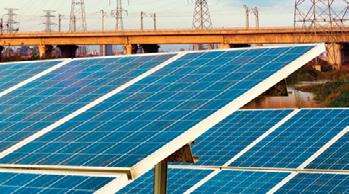
Ramkrishna Forgings is planning multi-crore investments to set up around 85 mega watt (MW) renewable energy capacity, company CFO Lalit Khetan has said.
The company aims to execute the plan over the next 12 months, Khetan said. Out of the planned 85 MW green capacity, about 8 MW roof-top solar project will be set up at the company’s forging plants at Sariekella and Dugni, in Jamshedpur, he told PTI.
“The total cost of the 8 MW project is estimated to be approximate ly Rs 35 crore, which will be financed by a mix of debt and equity,” Kehtan, who is also the Executive Director of the company said.
The power generated will be used for captive consumption, reducing the company’s dependence on grid power, he said. When asked if the company plans more green projects to increase usage of clean energy, Khetan replied in affirmative. “Our commitment is responsible business practices and dedication to reducing carbon footprint. We look to explore setting up another solar capacity of up to 75 MW in Jamshedpur,” he
said. The company official, however, did not provide any financial details of the 75 MW renewable energy capacity. As per industry estimates, to set up 1 MW of solar project, investment of around Rs 5 crore is needed. “These projects will help us achieve our goal of carbon neutrality by 2030,” he said. Kolkatabased Ramkrishna Forgings is a manufacturer and supplier of closed-die forgings of carbon and alloy steel, micro-alloy steel and stainless steel forgings. The company also has presence in countries like the US, Mexico, Istanbul, Turkey and Belgium.
Source: PTI
22 EQ MARCH 2023 www.EQMagPro.com INDIA
RELIANCE TO SET UP 10 GIGAWATT SOLAR ENERGY PROJECT IN AP: MUKESH AMBANI

SReliance Industries Chairman Mukesh Ambani said his group will be investing in Andhra Pradesh to set up a 10 gigawatt renewable solar energy project peaking at the inaugural session of the twoday Global Investors Summit 2023 here, Ambani said as much as Rs 1.50 lakh crore was invested in Reliances’ KG-D6 assets, developing and supporting gas pipeline and the natural gas produced there is fuelling India’s clean energy transition and will contribute to nearly 30 per cent of the country’s gas production.
“I would like to assure you that Reliance will continue to be an unflinching partner to the people and the Government of Andhra Pradesh in your state’s allaround accelerated progress. This morning, I am happy to announce that we will continue our investments and we will invest in 10 gigawatts of renewable solar energy in the state of Andhra Pradesh, Ambani said.
According to him, the rollout of Jio True 5G will be completed by the end of 2023 throughout the country and the 4G network covers 98 per cent of AP’s population, including those living in the remotest corners of the state. The rollout of Jio’s True 5G will be completed before the end of 2023 throughout India, including your state of Andhra Pradesh. Jio’s True 5G, will trigger a new wave of digital revolution in Andhra Pradesh, benefiting every sector of the economy, he said. Ambani said under the
determined and farsighted leadership of Prime Minister Narendra Modi, India has now become the fastest growing economy in the world.
Similarly, Andhra Pradesh has grown phenomenally under the leadership of Chief Minister YS Jagan Mohan Reddy,

Reliance Retail has partnered with more than 1.2 lakh Kirana merchants across 6,000 villages of the state equipping them with tools needed to thrive and succeed in the digital age and the vertical created over 20,000 direct jobs and a large number of indirect jobs in AP, he explained. Reliance Retail will source significantly more agri and agrobased products and manufactured goods from AP for sale all over India. Apart from increasing the income of farmers, artisans and others, this will directly create over 50,000 livelihood opportunities in the state, he added.
Source: PTI
NTPC CONFERRED WITH THE CBIP AWARD 2022 FOR ‘OUTSTANDING CONTRIBUTION IN POWER GENERATION
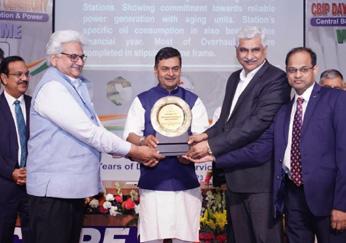
NTPC Limited, has been honoured with the CBIP Award 2022 for ‘Outstanding Contribution in Power Generation’, attributed to its Vindhyachal Super Thermal Power Station, the largest power station in the country for its efficiency and high level of generation.
The award presented by Shri R.K. Singh, Hon’ble Union Minister of Power, New & R.E, Govt. of India was received by Shri Ramesh Babu V, Director (Operations) and Shri Praveen Saxena, Regional Executive Director ( NR), Shri Suvash Chandra Naik, Executive Director (Vindhyachal) was also present at the Scope Convention Centre, New Delhi, on the occasion of the CBIP Day. NTPC stands committed to generating power responsibly and sustainably and occupies the premier position in the Indian energy sector in terms of size and efficiency. The CBIP Awards are conferred to institutions/individuals for their outstanding contributions to the development of water, power and Renewable Energy Sectors. The award stands as testimony to NTPC’s enduring contribution to the generation of power in the country.
www.EQMagPro.com 23 EQ MARCH 2023 INDIA
Mr. YS Jagan Mohan Reddy, Chief Minister of Andhra Pradesh
ADANI GREEN’S OPERATING RENEWABLE PORTFOLIO REACHES RECORD LEVEL OF 8,024 MW
Adani Green Energy said its 700-MW hybrid green energy project has become operational, which took its total operating renewable portfolio to 8,024 MW, the largest in India

Adani Green Energy said its 700-MW hybrid green energy project has become operational, which took its total operating renewable portfolio to 8,024 MW, the largest in India. The project is its fourth wind-solar hybrid power plant fully operational at Jaisalmer in Rajasthan, a company statement said. It stated that the 700-MW plant is the world’s largest wind-solar hybrid power plant.
“With the successful operationalisation of the 700-MW plant, the world’s largest wind-solar hybrid power plant, AGEL now has the largest operating renewable portfolio in India with 8,024 MW,” it said.
The combined operational generation capacity of this newly added hybrid power plant is 700 MW and has a Power Purchase Agreement (PPA) at Rs 3.24/kwh for 25 years. This new hybrid power plant consists of a combination of 600 MW solar and 510 MW wind plants. The latest hybrid plant deploys ad vanced renewable technologies like bifacial solar PV modules and horizontal single-axis trackers (HSAT) systems to enable maximum electricity generation from solar energy. The plant is co-located and is designed to deliver CUF of minimum 50 per cent, the highest CUF of any renewable project in India. The plant harnesses the potential of renewable energy by resolving intermittency of the generation and provides a more reliable solution to meet the rising power demand. The plant is housed under AGEL’s 100 per cent subsidiary Adani Hybrid Energy Jaisalmer Four Limited. Earlier in May 2022, it had operationalised India’s first hybrid power plant of 390 MW. This was followed by the commissioning of the world’s largest colocated hybrid power plant of 600 MW in September 2022 and the third hybrid power plant of 450 MW in December 2022. All three of these hybrid energy generation assets are located in Jaisalmer, Rajasthan.
GOVT ACCEPTS EXPERT PANEL REPORT ON SMART ELECTRICITY TRANSMISSION SYSTEM INDIA
The government has accepted a report of a task force or expert panel which paves the way for modern and smart electricity transmission system in India, the Ministry of Power said in a statement.

“The country will soon have a modern and smart power transmission system with features such as real-time monitoring and automated operation of grid, better situational assessment, capability to have increased share of renewable capacity in the power-mix, enhanced utilisation of transmission capacity, greater resilience against cyber attacks as well as natural disasters, centralised and data-driven decision-making, reduction in forced outages through self-correcting systems etc.,” the ministry said.
These and other recommendations are part of a report of a task force set up by the power ministry in September 2021 under the chairmanship of Powergrid chairman and managing director to suggest ways for modernisation of transmission sector and making it smart and future-ready, it stated. The task force in its report has recommended a bouquet of technological and digital solutions, which can be adopted to make the state transmission grids future ready. These recommendations have been clubbed under categories of modernisation of existing transmission system; use of advanced technology in construction and supervision, operations and management; smart and future-ready transmission system; and up-skilling of workforce.
The task force also recommended benchmarks for transmission network availability and voltage control based on performance of global transmission utilities. While the short-term to medium term recommendations will be implemented over 1-3 years, the long-term interventions are proposed to be implemented over a period of 3-5 years, it stated. The other members of the task force included representatives from state transmission utilities, Central Electricity Authority (CEA), central transmission utilities, MeiTY (Ministry of Electronics and Information Technology), IIT Kanpur, NSGPMU and EPTA. The report of the committee was accepted by the government after deliberations with Union power minister R K Singh last week, it stated. During the meeting, the minister emphasised that a modern transmission grid is vital to achieve the government’s vision to provide 24×7 reliable and affordable power to the people and also meet the sustainability goals. Singh said that a fully automated, digitally controlled, fast responsive grid which is resilient to cyber attacks and natural disasters is the need of the hour. The minister said that such a system should ensure isolation of specific areas in case of any contingency, so as to protect the grid and prevent larger outages.
Source: livemint
24 EQ MARCH 2023 www.EQMagPro.com INDIA
INDIA TO HAVE A MODERN AND SMART POWER TRANSMISSION SYSTEM; GOVERNMENT ACCEPTS THE TASK FORCE REPORT
Future-ready Transmission System to allow greater mixing of renewable energy, better utilization of existing transmission capacity, fewer outages and resilience against cyber-attacks and natural disasters
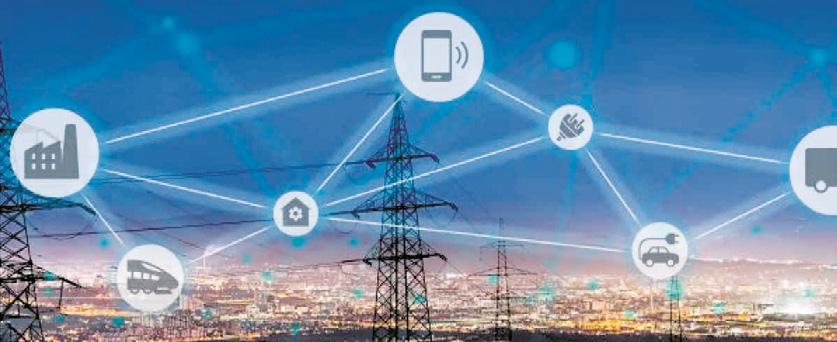

The system to use predictive maintenance technique using Artificial Intelligence and Machine Learning; Robots & Drones to be used in construction and inspection of transmission assets Modern Transmission Grid necessary to achieve government’s vision of 24X7 reliable & affordable power and meet sustainability goals, says Union Power & NRE Minister Shri R. K. Singh
CEA to formulate necessary standards and regulations to for adoption of identified technological solutions and set benchmark performance levels The country will soon have a modern and smart power transmission system with features such as real-time monitoring and automated operation of grid, better situational assessment, capability to have increased share of renewable capacity in the power-mix, enhanced utilization of transmission capacity, greater resilience against cyber-attacks as well as natural disasters, centralized and data driven decision-making, reduction in forced outages through self-correcting systems etc. These and other recommendations are part of a report of a task force set up by the Power Ministry in Sep, 2021 under the chairmanship of CMD, POWERGRID to suggest ways for modernization of Transmission Sector and making it smart & future ready. The other members of the Task Force included representatives from State Transmission Utilities, Central Electricity Authority, Central Transmission Utilities, MeiTY, IIT Kanpur, NSGPMU and EPTA The report of the committee was accepted by the government after deliberations chaired by Union Power & NRE Minister Shri R. K. Singh last week. During the meeting, the Minister emphasized that a modern transmission grid is vital to achieve the government’s vision to provide 24×7 reliable and affordable power to the people and also meet the sustainability goals. Shri Singh said
that a fully automated, digitally controlled, fast responsive grid which is resilient to cyber attacks and natural disasters is the need of the hour. The Minister said that such a system should ensure isolation of specific areas in case of any contingency, so as to protect the grid and prevent larger outages. Appreciating the efforts of the Task Force, Shri Singh directed the CEA to formulate necessary standards and regulations to for adoption of identified technological solutions and set benchmark performance levels so as to build a robust and modern transmission network in the country. The Task force in its report has recommended a bouquet of technological and digital solutions which can be adopted to make the state transmission grids future ready.These recommendations have been clubbed under categories of modernization of existing transmission system; use of advanced technology in construction & supervision, operations & management; smart & future-ready transmission system; and up-skilling of workforce. The Task Force has recommended Centralized Remote Monitoring, Operation of Substations including SCADA, Flexible AC Transmission devices (FACTs), Dynamic Line Loading system (DLL), Wide Area Measurement System (WAMS) using PMUs and data analytics, Hybrid AC / HVDC system, Predictive maintenance technique using AI/ML algorithms, HTLS Conductors, Process Bus based Protection Automation and Control GIS/Hybrid Substation, Cyber Security, Energy Storage System and Drones & Robots in construction/inspection of transmission assets. The use of robots is expected to not only minimize human intervention and minimize life risks/hazards but also save time with while ensuring accuracy during construction and maintenance. The Task force also recommended benchmarks for transmission network availability and voltage control based on performance of global transmission utilities. While the short-term to medium term recommendations will be implemented over 1-3 years, the long-term interventions are proposed to be implemented over a period of 3-5 years.

www.EQMagPro.com 25 EQ MARCH 2023 INDIA
MERCEDES SET TO INVEST BILLIONS IN E-VEHICLES PLANTS
Mercedes will invest billions of dollars to modernise its plants in China, Germany and Hungary over the coming years, magazine Automobilwoche reported, as the carmaker prepares to switch to electric vehicles and cut emissions.
OLA ELECTRIC
TO RAISE $300 MN FOR EXPANSION PLANS TO MEET CORPORATE NEEDS
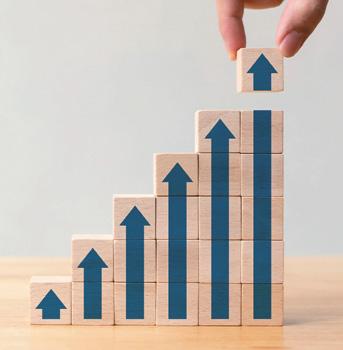

E-vehicle manufacturer Ola Electric is close to raising funds of around USD 300 million for its expansion plans and to meet other corporate needs, sources close to the company said.
The fresh round of fundraising comes amid expectations that Ola Electric would break even soon and achieve profitability. The fundraising would be managed by investment bank Goldman Sachs, and the funds would be raised from existing and marquee global investors and sovereign funds, the sources added. With close to a billion dollar annual revenue run rate, Ola Electric led the pack of Indian EV manufacturers by volume and revenue within a year of beginning deliveries of its electric scooters — Ola S1 and Ola S1 Pro. The company has been building on its plan to develop core technologies like cell manufacturing, and is looking to expand its product portfolio across segments of twowheelers and four-wheelers.
Ola Electric had recently signed an MoU with the Tamil Nadu government to acquire land to set up the world’s largest EV hub at a single location, in Krishnagiri, which will include the company’s cell factory, four-wheeler factory and supplier ecosystem. The company also intends to expand its existing two-wheeler factory, sources said. The electric two-wheeler manufacturer has been clocking an average monthly run rate of over 20,000 units. Its expansion plan includes the opening of 500 Experience Centres across all major cities by April 2023.
The European Union has set a goal to halve CO2 emissions per passenger car over their life cycle by the end of this decade compared to 2020 and is seeking agreement on a 2035 deadline to end the sale of fossil fuel cars. Mercedes has said it will be ready to go electric by the end of the this decade, where market conditions allow.
“We are investing a three-digit million amount per plant for the run up,” production manager Joerg Burzer was quoted as saying by the magazine, adding that these investments will be at the plants in Beijing, Rastatt in Germany and Kecskemet in Hungary.
The carmaker will start work on the Rastatt plant over the coming months and will produce the first model of the compact vehicle platform MMA from 2024. The number of models produced there will be cut to four from seven, Burzer said. In addition, Mercedes will invest a low single-digit billion dollar sum in modernising the painting systems at its Sindelfingen, Bremen and Rastatt plants in Germany. The report said the modernisation aims to cut energy and water consumption, and the painting system’s reliance on gas, as opposed to carbon-free energy. Mercedes is also considering expanding its U.S. plant in Tuscaloosa, where it can benefit from government subsidies under last year’s Inflation Reduction Act, Automobilwoche said. Burzer said Mercedes was ready to respond to any further changes in the regulatory environment.
“The framework conditions worldwide change again and again, we may have to react to that,” Burzer said.
Source: Reuters
26 EQ MARCH 2023 www.EQMagPro.com BUSINESS & FINANCE
MAINSTREAM RENEWABLE POWER AND ACTIS COMPLETE SALE OF LEKELA POWER
Transaction generates net proceeds to Mainstream of approximately USD 90 million, subject to certain closing adjustments
Lekela is the African continent’s largest pure-play renewable energy Independent Power Producer (`IPP’) with over 1 GW of fully operational wind assets
The planned exit reflects the successful culmination of Mainstream and Actis’ partnership strategy for Lekela
Reference is made to the stock exchange announcement by Aker Horizons ASA dated 18 July 2022 regarding Mainstream Renewable Power (“Mainstream”), the global wind and solar company majority-owned by Aker Horizons, and Actis’, a leading global investor in sustainable infrastructure, agreement to sell the Lekela Power platform. Mainstream and Actis today announced the completion of the sale of 100 percent of the Lekela platform to Infinity Power, a joint venture between Egypt’s Infinity and UAE’s Masdar.
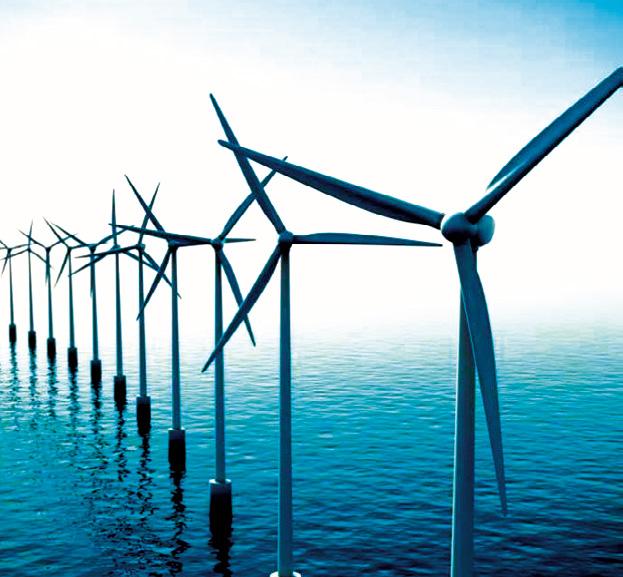
The transaction generates net proceeds to Mainstream of approximately USD 90 million, subject to certain closing adjustments, with the transaction valued at an enterprise value of approximately USD 1.5 billion. Lekela was established in 2015 in a joint venture between Actis (60 percent), and a Mainstream-led consortium called Mainstream Renewable Power Africa Holdings (‘MRPAH’) (40 percent), to deliver clean, reliable energy across Africa. Lekela has since become Africa’s largest pure-play renewable energy IPP, with over 1 GW of fully-operational wind assets, including five operational wind farms in South Africa (624 MW), one operational wind farm in Egypt (252 MW), one operational wind farm in Senegal (159 MW) as well as development opportunities in Ghana, Senegal and Egypt. The exit reflects the successful culmination of Actis and Mainstream’s partnership strategy for Lekela, following a comprehensive value creation approach. With the support of Actis and Mainstream’s dedicated sustainability professionals, Lekela has implemented the highest international standards in health, safety and environmental protection.
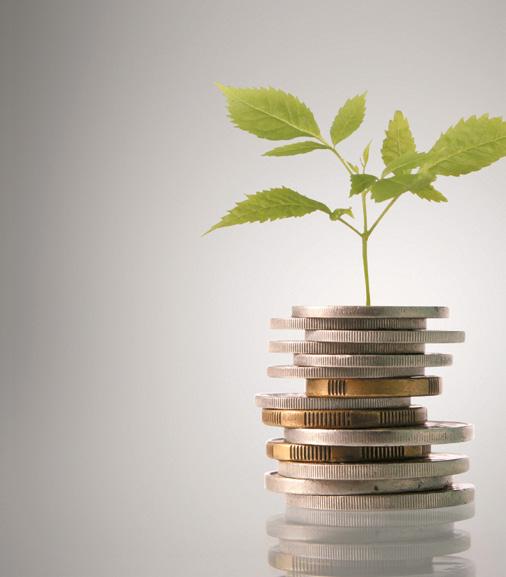
Lekela has also developed a deep commitment to local development and continues to operate a community investment programme that finances entrepreneurship, educational and environmental protection initiatives. Throughout the development, construction and operations journey, Actis and Mainstream have delivered on their robust sustainable development standards, guided by close engagement with local communities. “We are immensely proud of the role we have played in building and nurturing what is today Africa’s largest pureplay renewable energy IPP and I am confident that Lekela will continue to make a major contribution to a just, and therefore sustainable, energy transition. Mainstream is deeply committed to our mission of leading the global transition to renewable energy and our 150-strong proudly South African team is focused on bringing our 11.5 GW pipeline of wind and solar projects in South Africa to fruition this decade and beyond,” said Mary Quaney, Group Chief Executive of Mainstream Renewable Power.
Citi and Clifford Chance advised Mainstream and Actis on the Lekela transaction.
www.EQMagPro.com 27 EQ MARCH 2023 BUSINESS & FINANCE
GREENHOUSE GAS PROTOCOL RECEIVES $9.25 MILLION GRANT FROM THE BEZOS EARTH FUND



Today the Earth Fund announced its award of $9.25 million to Greenhouse Gas Protocol, which is co-convened by World Resources Institute and the World Business Council for Sustainable Development. The partnership will allow GHG Protocol to update and clarify existing standards, develop new guidance, improve efficiency, and provide additional technical services to companies. This work will support GHG Protocol users’ implementation of greenhouse gas emissions accounting and reporting standards.
In November 2022, GHG Protocol launched a set of surveys on its Corporate Accounting Reporting Standard, Scope 2 Guidance, and Scope 3 Standard and Scope 3 Calculation Guidance to better understand users’ challenges with implementing the standards. The global stakeholder survey process will inform future revisions to existing standards or development of additional guidance and sets the stage for the next two years of GHG Protocol’s work. By soliciting feedback from users on pain points, as well as users’ suggestions for revisions, GHG Protocol is working to better serve practitioners on the ground.
Ani Dasgupta, President & CEO of World Resources Institute, emphasized the foundational role that GHG Protocol has played in the GHG emissions and accounting ecosystem. “For over twenty years, GHG Protocol has supplied the world’s most widely used greenhouse gas accounting standards which have come to underpin virtually every corporate GHG reporting program,” he said. “This generous award in partnership with the Earth Fund comes at a critical inflection point as the GHG Protocol updates its standards and guidance and significantly ramps up the support it provides to thousands of corporate users.”

This funding will be pivotal to expanding GHG Protocol’s capacity as interest in GHG emissions accounting grows from voluntary to regulatory programs, said Pankaj Bhatia, Director of GHG Protocol. “GHG Protocol has provided comprehensive standards and tools for businesses, cities, and governments to credibly measure their GHG emissions and track progress toward their climate targets, and we are seeing an exponential increase in demand for support in this field.” he said. “This investment will allow us to continue to further strengthen our vital role for years to come.”
Source: wri
SEMBCORP AWARDED FIRST GREENFIELD RENEWABLES PROJECT IN THE MIDDLE EAST


The 500MW build-own-operate solar plant will augment Sembcorp’s well-established presence in the Sultanate of Oman’s power and water desalination sector
Sembcorp Industries (Sembcorp) announces that it has, through an 80%-owned joint venture to be set up by its wholly-owned subsidiary Sembcorp Utilities with Jinko Power Technology (Jinko Power), received an award by Oman Power and Water Procurement Company (OPWP) to build, own and operate the Manah Solar II Independent Power Project (IPP) in Manah, Sultanate of Oman. The 500MW solar plant is expected to be operational by 2025 and will be backed by a 20-year power purchase agreement with OPWP. This project will complement Sembcorp’s existing capabilities and track record in the region. The Salalah Independent Water and Power Plant, one of the most energy-efficient power and water plants in the Dhofar region in the Sultanate of Oman, is 40% owned by Sembcorp.
Andy Koss, CEO of UK & Middle East, Sembcorp Industries, said, “The Manah Solar II IPP will mark Sembcorp’s first renewables project in the Middle East. To be constructed in the Sultanate of Oman, the project will leverage our strong network and presence for over 10 years in the country built through Salalah Independent Water and Power Plant. We are delighted to be awarded this project and look forward to working with Jinko Power to support the global energy transition.”
This project is expected to be financed through a mix of internal cash resources and external bank borrowings. It is not expected to have a material impact on the earnings per share, net asset value per share and leverage of Sembcorp for the financial year ending December 31, 2023.
Source: sembcorp
28 EQ MARCH 2023 www.EQMagPro.com BUSINESS & FINANCE
VOLKSWAGEN PRESENTS NEW LOW-PRICE ELECTRIC CAR, ID.2ALL

The Volkswagen brand is continuing the success story of its compact cars in the age of electric mobility and is providing a first glimpse of an allelectric Volkswagen costing less than 25,000 euros with the ID. 2all concept car. Initial facts: front-wheel drive, range of up to 450 km, innovative technological features such as Travel Assist, IQ.LIGHT or Electric Vehicle Route Planner and a new Volkswagen design language. The production version will be based on the MEB Entry platform and is one of ten new electric models that Volkswagen will launch by 2026.
Exterior design: friendly face, very dynamic and new C-pillar signature
Thomas Schäfer, CEO of Volkswagen Passenger Cars: “We are transforming the company rapidly and fundamentally –with the clear objective of making Volkswagen a genuine Love Brand. The ID. 2all shows where we want to take the brand. We want to be close to the customer and offer top technology in combination with fantastic design. We are implementing the transformation at pace to bring electric mobility to the masses.”
Volkswagen will present the production version of the ID. 2all for the European market in 2025. The goal is a starting price of less than 25,000 euros.

Imelda Labbé, Member of the Brand Board of Management responsible for Sales, Marketing and Aftersales: “We are transferring the typical Volkswagen virtues to the new world of mobility: top quality and workmanship, outstanding software and digital services with genuine added value. The focus here is always on the needs and requirements of our customers.”
Development of the ID. 2all is based on the latest evolutionary stage of the modular electric drive (MEB) platform. Kai Grünitz, Member of the Brand Board of Management responsible for Technical Development: “The ID. 2all will be the first MEB vehicle with front-wheel drive. We are exploiting the great flexibility offered by our modular electric drive (MEB) platform and will set new standards in terms of technology and everyday usability with the MEB Entry platform.” With the enhanced MEB Entry platform, the ID. 2all is equipped with particularly efficient drive, battery and charging technology. It has a powerful electric drive motor with an output of 166 kW/226 PS and will have a calculated WLTP range of up to 450 kilometres. Volkswagen is also again placing greater focus on design. Andreas Mindt, Head of Design at Volkswagen Passenger Cars: “The ID. 2all gives a preview of the new design language of Volkswagen, which is based on the three pillars stability, likeability and enthusiasm.”
One element of this new design language is the C-pillar design developed for the first Golf. The ID. 2all is the first Volkswagen with a new interpretation of this signature. Other design features of the concept car include a body with a clear and powerful stance on the wheels, a friendly face, a good portion of dynamics and timeless elegance.
Interior design: spacious, high-quality appearance, self-explanatory operation
The interior also has a clear design and is characterised by a high-quality appearance, a self-explanatory infotainment system with classic volume control and a separate air conditioning block. The storage volume is a generous 490–1,330 litres, a value exceeding that of higher vehicle classes.
Accelerated electric offensive: ten new electric models by 2026

The production version of the ID. 2all is one of ten new electric models that will be launched by Volkswagen by 2026. This year alone will see the introduction of the new ID.3, the ID. Buzz with long wheelbase and the ID.7. This will be followed by a compact electric SUV in 2026 and, in spite of all the challenges, Volkswagen is also working on an electric car at a price of less than 20,000 euros. This will give the car manufacturer the widest range of electric vehicles compared with its competitors, and the company is aiming to achieve an electric car share of 80% in Europe. Volkswagen Passenger Cars has previously based its calculations on a share of 70%.
TECHNICAL DATA OF THE ID. 2ALL


Drive MEB Entry, front-wheel drive
Output 166 kW / 226 PS
Range approx. 450 km (WLTP)
Charging time 10 to 80% in approx. 20 min. 0–100 km/h < 7 s
Top speed 160 km/h
Length 4,050 mm
Width 1,812 mm
Height 1,530 mm
Wheelbase 2,600 mm
Storage volume 490 to 1,330 l
Wheels 225/40 R20
Source: volkswagen
www.EQMagPro.com 29 EQ MARCH 2023 BUSINESS & FINANCE
CIP AND VIVIID PARTNER TO DEVELOP 1.8GW RENEWABLE ENERGY PROJECTS IN INDIA
The partnership involves Viviid contributing projects from its development pipeline in India to the venture, as well as delivering development activities with CIP leading the sourcing of offtakers, procurement activities and the financing process. CIP said the partnership, being made through its Copenhagen Infrastructure New Markets Fund (CI NMF) I, will mainly focus on onshore wind projects. It will initially develop two onshore wind projects with a 500MW combined capacity, with a plan to develop further projects through follow-on CI NMF funds. The CI NMF I fund was established in November 2019 with a total commitment of $1bn (€929m). The fund mainly targets greenfield renewable energy infrastructure projects in fast-growing economies in Asia and Latin America, and certain countries in Eastern Europe.
Peter Sjøntoft, an associate partner at CIP, said:

“This is the second CI NMF I partnership in the Indian renewable energy market, reflecting India’s continuing importance as a key focus area for the fund. With this partnership we are significantly strengthening our foothold in India and are delighted to partner with Viviid and look forward to working alongside their highly experienced team, combining our joint expertise to assist the green transition in the country.”
Siddharth Mehra, founder of Viviid, said: “We are very excited to be partnering with CIP to accelerate delivery of our project pipeline over the coming years. Through this long-term partnership, we aim to further strengthen our contribution to India’s ambitious target of installing 500GW of generation capacity from renewable sources by 2030.”

Source: PTI
TATA POWER RENEWABLE GETS RS 2,000 CRORE INFUSION FROM GREENFOREST
GreenForest holds 6.06 per cent equity in TPREL and on conversion of the above CCPS, it will hold 9.76-11.43% stake in TPREL, subject to the equity valuation on final conversion
Tata Power Renewable Energy Ltd (TPREL) has received an investment of Rs 2,000 crore from GreenForest New Energies Bidco with allotment of 20 crore preference shares to the latter. “TPREL…has received the second and final round of investment of Rs 2,000 crore from GreenForest and has successfully allotted 20,00,00,000 Compulsorily Convertible Preference Shares (CCPS) at face value of Rs 100 each at par aggregating to Rs 2,000 crore on a preferential basis to GreenForest,” a statement said. Subsequent to this second tranche, TPREL has now received an investment of Rs 4,000 crore. GreenForest holds 6.06 per cent equity in TPREL and on conversion of the above CCPS, it will hold 9.76-11.43 per cent stake in TPREL, subject to the equity valuation on final conversion. The completion of this equity infusion will fund TPREL’s aggressive growth plans. Over the next five years, it aims to
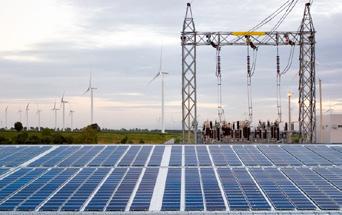
achieve a portfolio of 20 GW of renewable assets and a market leading position.
“The completion of Rs 4,000 crore (USD 525 million) worth capital infusion into our renewables business will fuel the next level of growth and help us play a pivotal role in India’s efforts to secure greater energy stability through low carbon solutions for a sustainable future,” said Praveer Sinha, CEO and MD, Tata Power in a statement.
Source: PTI

30 EQ MARCH 2023 www.EQMagPro.com BUSINESS & FINANCE
Copenhagen Infrastructure Partners (CIP) has teamed up with local renewable energy developer Viviid Renewables to develop 1.8GW of projects.
ENI, ADNOC INK PACT TO COOPERATE IN RENEWABLES, HYDROGEN, CARBON CAPTURE
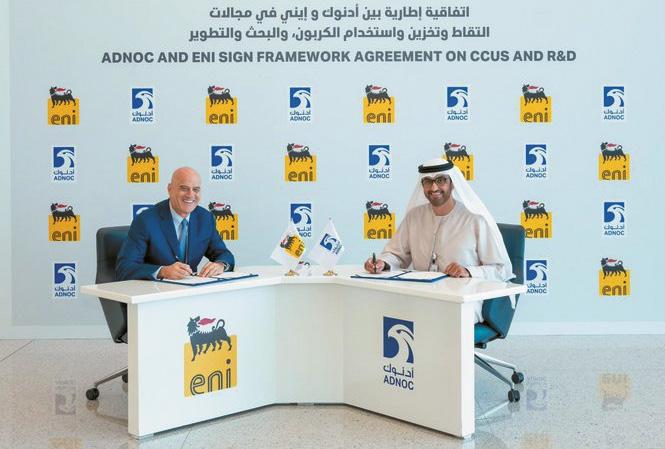
• Companies to collaborate in reducing GHG, methane emissions
• They plan to hit net zero emissions by 2050
• Eni is a major oil and gas producer in UAE
Italy’s Eni and the UAE’s Abu Dhabi National Oil Co. have signed a memorandum of understanding to explore collaboration in the development of renewable energy, blue and green hydrogen and carbon, capture and storage amid ADNOC’s plans to hit net zero scope 1 and scope 2 emissions by 2050. The two companies also will explore collaboration in the reduction of greenhouse gas, methane emissions, and routine gas flaring, Eni said in a March 4 statement. ADNOC plans to spend $15 billion on clean energy projects by 2030 as it seeks to decarbonize its operations. It has pledged to lower its carbon intensity by 25% by 2030 and has set an upstream methane intensity target of 0.15% by 2025. At the same time, ADNOC is boosting its oil production capacity to 5 million b/d by 2027 from over 4 million b/d now and will spend $150 billion between 2023-2027 to help fund this ramp-up. Eni also plans to boost its upstream production, which will grow at an average of 3%-4% per year from about 1.61 million b/d of oil equivalent in 2022 with output plateauing in 2025 to 2030. Despite the higher output guidance, Eni is sticking with targets to reduce its scope 1, 2 and 3 emissions by 35% by 2030 and by 80% by 2040 ahead of hitting net zero emissions by 2050. The UAE, OPEC’s third biggest producer, has pledged to have net zero emissions by 2050, the first country in the Middle East to make such a commitment. It will be hosting the UN Climate Change Conference (COP28) in November.
CARBON CAPTURE PROJECTS
ADNOC already plans to boost its carbon capture and storage capacity to 5 million mt/year by 2030 from 800,000 mt/year now. It is also developing with partners a 1 million mt/year blue hydrogen project in the industrial hub of Ruwais in the emirate of Abu Dhabi. Through its stake in Abu Dhabi-based renew
ables firm Masdar, ADNOC will be involved in the company’s projects, including plans to develop as much as 1 million mt/ year of green hydrogen by 2030 and boost installed renewables power capacity to as much as 100 GW by 2030 from over 20 GW now. Eni is working with ADNOC to build a carbon capture and storage plant and an enhanced oil recovery project in the Bab field. Eni pumped 17 million barrels of oil and condensate and produced 6 bcf in the UAE in 2021 according to its website Eni is in talks with the ADNOC to speed up the development of gas projects, including the Ghasha sour gas development, and the recent discovery in Offshore Block 2 off Abu Dhabi, according to a September statement.
ENI’S UAE CONCESSIONS
Production from the Ghasha concession, the world’s largest offshore sour gas development, is expected to start around 2025 and ramp up to reach more than 1.5 bcf/d before the end of the decade. The Ghasha concession comprises the Hail, Ghasha, Hair Dalma, Satah, Bu Haseer, Nasr, SARB, Shuwaihat and Mubarraz fields. ADNOC’s partners in the Ghasha concession are Eni (25%), Germany’s Wintershall Dea (10%), Austria’s OMV (5%), and Russia’s Lukoil (5%). Eni also has a 70% stake and is operator of Offshore Block 2, with partner PTTEP of Thailand holding the remaining interest. The Italian major is the operator of three exploration concessions in the UAE and has a participation with ADNOC in three offshore development and production concessions, Lower Zakum (5%), Umm Shaif and Nasr (10%) and Ghasha (25%). Eni also owns 20% of ADNOC Refining, a joint venture with ADNOC and Austria’s OMV. It also has a 20% stake in ADNOC Global Trading, a joint venture with ADNOC and OMV focused on refined products.
Source: spglobal
www.EQMagPro.com 31 EQ MARCH 2023 BUSINESS & FINANCE
GREENKO RAISES US$ 700 MILLION IN EQUITY FUNDING FOR GROWING ITS CLOUD STORAGE PLATFORM TO ~50 GWH

Greenko Energy Holdings (“Greenko”), one of India’s leading energy transition companies, has announced the signing of definitive agreements for a primary equity raising of US$ 700 million from affiliates of GIC, a wholly owned subsidiary of the Abu Dhabi Investment Authority, ORIX Corporation and the Founders to spearhead and accelerate the energy transition and decarbonisation efforts through supply of Carbon Free Energy (“CFE”). There is no change in shareholding structure post this investment.

The US$ 700 million investment will be used towards the capex of pumped storage projects which will have storage capacity of more than 25 GWh, enabling 45 billion units of dispatchable CFE. These assets have a 100-year life and are currently the most economical long duration energy storage solution.
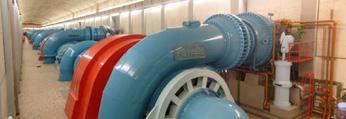
Anil Kumar Chalamalasetty, CEO and Managing Director at Greenko said: “This equity commitment from the existing shareholders reinforces their trust in our vision. Greenko is leading India’s energy transition through implementation of large scale and long-term solutions, and it continues to deliver long-term value to all our stakeholders. CFE is helping accelerate industrial decarbonisation, enhancing green quotient of Indian grid and development of green molecules and chemicals at a competitive cost.”

Mr. Ang Eng Seng, Chief Investment Officer of Infrastructure at GIC, said: “Costeffective long duration energy storage is key to unlocking widespread adoption of renewable energy, accelerating India’s energy transition plans, and spurring the global transition to a net-zero economy. Greenko is uniquely positioned as the leading market provider of long-duration energy projects through its pumped storage projects. We are pleased to support Greenko’s continued growth momentum in this sector.”

OCIOR ENERGY SIGNS MOU WITH GUJARAT GOVT TO INVEST RS
40,000 CR IN GREEN HYDROGEN,
AMMONIA
It added that the renewable energy project will become operational by 2030 in two phases and it is expected to generate nearly 10,400 direct as well as indirect employment opportunities. Ocior is a leading company in the field of green hydrogen and green ammonia started in Abu Dhabi Global Market, United Arab Emirates. The company aims to develop 4 GW capacity green hydrogen and green ammonia projects across the India, Middle East and North Africa (MENA) region, the release said.
32 EQ MARCH 2023 www.EQMagPro.com
The Gujarat government signed a memorandum of understanding (MoU) with Ocior Energy India Pvt Ltd for the production of green hydrogen and green ammonia with an investment of Rs 40,000 crore. As per the MoU, signed in the presence of Gujarat Chief Minister Bhupendra Patel, Ocior Energy will invest Rs 40,000 crore in Kutch district of Gujarat to set up a facility to produce 1 million tonnes of green hydrogen and ammonia per annum, said an official release.
Source
: PTI
BUSINESS & FINANCE
BUSINESS & FINANCE
ADANI GROUP TO HOLD FIXED-INCOME ROAD SHOWS IN LONDON, DUBAI, ‘SEVERAL’ US CITIES: REPORT
Adani Group Chief Financial Officer Jugeshinder Singh is likely to attend the road shows, which will run between March 7 to March 15
Adani Group will hold fixed-income road shows this month in London, Dubai, and several cities in the United States, according to a document seen by Reuters, as the conglomerate tries to boost investor confidence after it took a beating due to US short-seller Hindenburg Research’s scathing report. Adani Group management, including Group Chief Financial Officer Jugeshinder Singh, will attend the road shows which will run between March 7 to March 15, Reuters reported. The development comes at a time when Adani Group stocks rallied after four Adani firms cumulatively raised Rs 15,446 crore from US investment firm GQG Partners, which eased concerns about the conglomerate’s ability to attract funding. Adani firms said that GQG bought 3.4% of Adani Enterprises Ltd for about $662 million, 4.1% of Adani Ports and Special Economic Zone Ltd for $640 million, 2.5% of Adani Transmission Ltd for $230 million and 3.5% of Adani Green Energy Ltd for $340 million. Shares of flagship Adani Enterprises rose as much as 17.5%, while Adani Ports surged 10%. Adani Green Energy and Adani Transmission jumped 5%
each. Dollar bonds issued by Adani entities also rallied, with Adani Green Energy’s 2024 bond adding 2.3 cents on the dollar to trade at 85.5 cents, while most bonds issued by Adani Ports and Special Economic Zone, Adani Transmission and Adani Electricity Mumbai rose by more than 1 cent. GQG’s Sydney-listed shares, meanwhile, ended down 3%, compared with a 0.4% rise in the benchmark index. The stake purchase by the boutique investment firm marked the first major investment in billionaire Gautam Adani’s conglomerate since Hindenburg’s critical report resulted in seven of the Indian group’s listed firms losing about $130 billion in market value. In the Jan. 24 report, Hindenburg Research noted high debt and alleged improper use of offshore tax havens and stock manipulation, which Adani denied. A dive in Adani stocks then prompted the group to shelve a $2.5-billion share sale.
GQG’s deal “may assuage concerns about the group’s ability to raise funding for the repayment of loans against its listed company shares,” analysts at Kotak Institutional Equities said.
Source: PTI
WONDER SOLAR TO INVEST RMB 1 BILLION IN 2GW PEROVSKITE CELL PROJECT

A ceremony to mark the simultaneous initiation of several major industrial projects in China’s Hubei Province in 2023 was held recently in the New City Area of Wuhan. The venue of the event had a section dedicated to the Ezhou Ge Shop Economic and Technological Development Zone; and within this section there was a celebration of the start of a perovskite cell project.
Notable attendees included the deputy mayor of Ezhou and the party committee secretary of the Ezhou Ge Shop Economic and Technological Development Zone. The perovskite cell project is being developed by Wonder Solar, a local company that supplies raw materials and pastes used in the manufacturing of PV products as well as PV cell arrays. This event was first reported by other Chinese renewable energy news websites. According to the reporting by Chinese media, Wonder Solar aims to manufacture and promote new kinds of low-cost PV devices. The company is developing a printing-based manufacturing process that can build highly efficient and reliable PV devices with low-cost raw materials. The company said that such energy solutions can be used to support the production of green hydrogen. The perovskite cell project that the company has initiated spans an area of 97 mu and entails an investment of RMB 1 billion. The project will be developed in three phases. Once it is fully completed and enters operation, its fully ramped-up production capacity will reach at least level of 2,000MW (2GW) per year. The perovskite cell project is expected to contribute to the acceleration of commercial applications for perovskite cells. It also aligns with China’s long-term strategy for the development of
clean energy. Won der Solar’s R&D efforts are touted to provide both the driving force behind innovations and the security of China’s possession of key energy technologies. A representative of Wonder Solar said the company’s operations link up several districts of Wuhan and Ezhou in terms academic research and industrial development. The company’s R&D activities take place in the Guanggu District, and the technologies resulting from R&D are then transferred to its facilities in the Liangzihu District for further improvements. As for the manufacturing operation, it is located in the Ge Shop Economic and Development Zone. All in all, the company is keeping its businesses within Wuhan (i.e. the New City Area) and Ezhou.
Source: energytrend
www.EQMagPro.com 33 EQ MARCH 2023
RELIANCE, TATA BID FOR INDIA’S $2.4 BILLION SOLAR INCENTIVES
Solar module makers including Reliance Industries Ltd. and Tata Power Co. are among bidders for 195 billion rupees ($2.4 billion) in financial incentives that India is offering to expand domestic manufacturing and curb panel imports from dominant producer China.
Others showing interest include U.S. firm First Solar Inc. and Indian companies JSW Energy Ltd., Avaada Group and ReNew Energy Global Plc, according to people familiar with the matter, who asked not to be named as the information hasn’t been made public. The embattled Adani Group, one of the country’s largest solar panel makers, was not among the bidders, the people said.
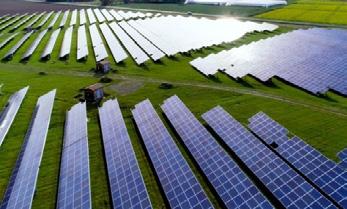

The financial assistance is part of Prime Minister Narendra Modi’s aim to turn the nation into a manufacturing powerhouse, creating more jobs in the economy and reducing imports that can drain foreign exchange. His “Make in India” campaign is an effort to showcase the country as an alternative to China amid a global push to diversify supply chains in the wake of the pandemic. The government is offering grants to take the country’s module-making capacity to as much as 90 gigawatts, enough to meet its own requirements and serve export markets. Still, the bids come amid concerns that the focus on domestic manufacturing is slowing down renewable power projects, undermining India’s transition targets. Power Minister Raj Kumar Singh said last month that his ministry is considering temporarily “relaxing” a key barrier to module imports to speed up projects.Spokesmen at Reliance, Avaada Group and JSW Energy declined to comment. The renewables ministry, as well as Adani, Tata Power, ReNew and First Solar, didn’t immediately respond to emailed requests for comment.The bids, being conducted by state-run Solar Energy Corp., closed Feb. 28, after being extended multiple times. Details on incentives and projects aren’t yet available.
Source : Bloomberg
CATL IS REPORTEDLY PLANNING TO RAISE
MORE THAN USD 5
BILLION FOR LISTING ON SIX SWISS EXCHANGE
With the “Shanghai-London Stock Connect” evolving into a wider “China-Europe Stock Connect”, many Chinese companies that are involved in the Li-ion battery industry are planning to issue GDRs in European exchanges so as to expand their overseas funding channels and internationalize their business operations. These companies include battery manufacturers, raw material suppliers, and component suppliers (e.g., those that sell cathodes, anodes, separators, electrolytes, etc.). Several major news platforms include IFR and Bloomberg reported on February 1 that CATL is considering to raise USD 5-6 billion for issuing GDRs in the SIX Swiss Exchange. The undisclosed sources that have knowledge of this plan said CATL has already undertaken internal discussions and consultations on getting listed and issuing GDRs, and this event could happen as early as this year. The other major Chinese battery manufacturers Gotion Hi-Tech and Sunwoda have successfully gotten themselves listed on the SIX Swiss Exchange. Gotion began issuing GDRs in July 2022, and it has raised around USD 685 million through sales of 2,283 units of GDRs. Sunwoda began issuing GDRs in November 2022, and it has raised around USD 440 million through sales of 2,875.9 units of GDRs. CATL started to speed up the pace its overseas expansion activities in 2022. With regard to courting foreign clients, CATL have established partnerships, in succession, with the following major carmakers: Ford, Mercedes-Benz, BMW, Daihatsu Motor, and Honda Automobile (China). CATL has also formed ties with solution providers and investors in the energy
storage market, including FlexGen and Primergy Solar from the US and Gresham House from the UK. Turning to capacity building, CATL has been quick to build overseas factories. Its plant in Arnstadt, a city in the German state of Thuringia, formally entered operation this January. The construction of the plant began in 2019, and CATL has invested around EUR 1.8 billion into this project. The initial production capacity of the plant is set at 14GWh per year. Once it is fully ramped up, the plant is expected to output around 30 million pieces of battery cells per year. This amount is sufficient to meet the battery installation demand of 185,000-350,000 electric vehicles per year. Earlier, CATL received permission from the German government to set up 8GW per year of production capacity for Liion battery cells, and the company achieved mass production in Germany in December 2022. Also, in August 2022, CATL announced it will land its second European plant in the Hungarian city of Debrecen. The investment in this project is planned at EUR 7.34 billion. Currently, CATL has the capability to locally supply batteries to European carmakers. Besides Europe, CATL is also expanding into other regions of the world. In April 2022, CATL announced that it will be collaborating with two enterprises controlled by the Indonesian government to develop an integrated battery manufacturing project that encompasses nicking mining and processing, EV battery materials, EV battery manufacturing, and battery recycling. The total investment in this project is set around USD 6 billion. Additionally, CATL is reportedly searching for a site in Mexico to set up a battery plant. According to the sources with knowledge on this matter, the proposed plant in Mexico will entail an investment of around USD 5 billion. It is expected to manufacture batteries used in Ford’s and Tesla’s vehicles.
34 EQ MARCH 2023 www.EQMagPro.com
BUSINESS & FINANCE
BUSINESS & FINANCE
TATA POWER JOINS HANDS WITH ENEL GROUP TO POWER DIGITALISATION, AUTOMATION IN ELECTRICITY DISTRIBUTION
“Tata Power joined hands with Enel Group — one of the largest integrated players in the global power and renewable markets — for implementing two key pilot projects through former’s Delhi based distribution business,” a company statement said.
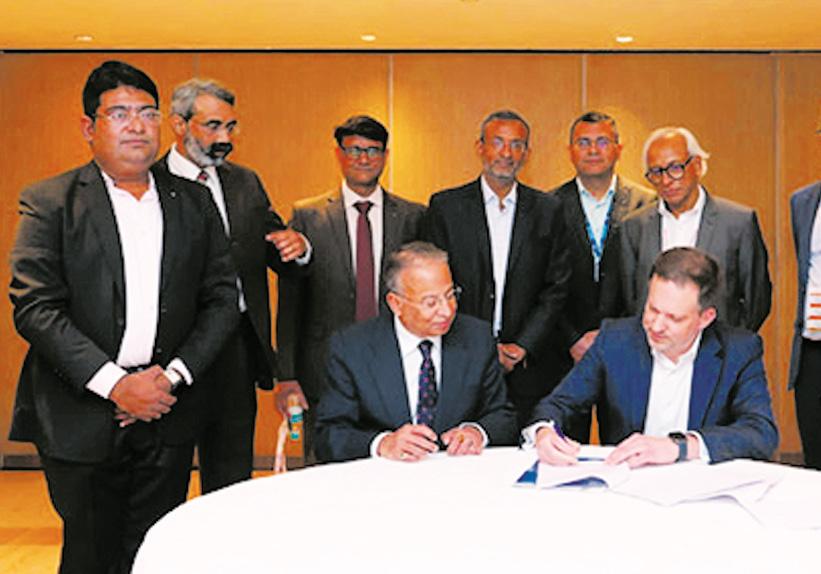
The agreement towards the same was signed by Robert Ronald Denda – CEO Gridspertise Srl, and Praveer Sinha, CEO & MD, Tata Power, in New Delhi.

proprietary QEd – Quantum Edge Device. This collaborative programme will virtualise grid functionalities and enable protection and control, automation, real-time fault detection and service restoration of the network. The other project is aimed at deploying Gridpertises’ metering technology on a pilot basis in the Delhi power distribution network. It focuses on testing and evaluating the new hybrid smart metering technology featuring dual communication channel, via hybrid Power Line Communication (PLC) and Radio Frequency (RF). It offers a robust, efficient and secure communication channel by auto-switching between PLC and RF channels depending on real time field conditions. Both the projects are in line with Tata believe that these tech advancements will pave the way for sustainable and future-ready discoms in the country.” Tata Power is spearheading major transformation in the Indian power distribution landscape via focussed tech interventions and manages a distribution network of more than 0.4 million circuit kilometres with 12 million customers across India via its discoms. It has also reached a milestone of installing 0.5 million smart meters.
The agreement was signed on the sidelines of the official visit of the President of the Council of Ministers of Italy Giorgia Meloni. Under the agreement, Tata Power’s distribution arm Tata Power Delhi Distribution Ltd (TPDDL), serving 1.9 million customers in north Delhi, will work closely with Enel Group affiliated company Gridspertise, jointly controlled by Enel Grids and CVC Capital Partners, on project implementation. The first pilot project will focus on to accelerating digitalisation and automation of secondary substations and see Tata Power joining the international co-creation programme of Gridpertise’s
Antonio Cammisecra, Head of Enel Grids, commented, “The agreements announced during the India Italy Business Roundtable result from years of close collaboration between the Enel Group and leading Indian power sector organisations.”
Source : PTI
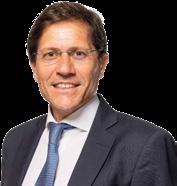
www.EQMagPro.com 35 EQ MARCH 2023
Tata Power said that it has collaborated with Enel Group to power digitalisation and automation of India’s distribution network.
ESSAR TO INVEST $3.6 BILLION IN ENERGY TRANSITION IN UK, INDIA


The Essar group announced a $3.6 billion investment in low carbon energy transition projects in the UK and India including the production of green hydrogen and ammonia over the next five years, as it looks at a new phase of growth. Essar Group, invested in energy, metals and mining, infrastructure and technology sectors, announced “the formation of Essar Energy Transition (EET) to drive the creation of the UK’s leading energy transition hub in North West England.”
“EET plans to invest a total of $3.6 billion in developing a range of low carbon energy transition projects over the next five years, of which $2.4 billion will be invested across its site at Stanlow, between Liverpool and Manchester and $1.2 billion in India,” the company said in a statement. The projects will include 1 gigawatt of blue hydrogen project being pursued by Vertex Hydrogen in the UK, a 1 GW of green ammonia facility targeted at the UK and international markets, and developing 1 MT of low carbon biofuels. Vertex is building a hydrogen manufacturing unit at Essar’s Stanlow refinery complex in the UK. The joint venture, in which Essar Oil UK holds 90%, will produce 1 gigawatt (GW) of hydrogen per year from two units from 2026. UK’s Progressive Energy holds the remaining 10 per cent in Vertex. Besides, EET will include Essar Oil UK, the company’s refining and marketing business in North West England and Vertex Hydrogen, which is developing 1 gigawatt (GW) of blue hydrogen for the UK market, with follow-on capacity set to reach 3.8 GW. It also includes EET Future Energy, which is developing 1 GW of green ammonia in India, targeted at UK and international markets; Stanlow Terminals Ltd, which is developing enabling storage and pipeline infrastructure; and EET Biofuels, which is investing in developing 1 MT of low carbon biofuels. “In addition to the $ 2.4 billion investment in the UK, EET will also invest $1.2 billion in developing a cost-efficient global supply hub for low carbon fuels in India, including green hydrogen and green ammonia.Ammonia will be shipped from India to the UK, Europe and
globally to meet expanding market demand for green hydrogen,” it said. EET’s investment in India will help deliver on the country’s emerging hydrogen ambition. The Indian government’s supportive regulatory framework is designed to help position the country as a leading global hub of green hydrogen production and exports, as set out in its National Green Hydrogen Mission, approved by the government on January 4, 2023.
Prashant Ruia, Director, Essar Capital, said: “The launch of EET is a major milestone in Essar’s long-standing commitment to put the UK at the forefront of low carbon energy. We are excited about the opportunity to drive the UK’s energy transition by producing low carbon future fuels which will help eliminate around 20% of the industrial carbon dioxide in Northwest England. “In doing so, it will provide a blueprint for how traditional industries globally can be successfully transformed into hubs for the production of future energies.”
Tony Fountain, Managing Partner of Essar Energy Transition, said: “EET’s ambitious investment plans will not only help deliver the UK’s net zero ambitions and the enormous environmental benefits therein, but will also secure the long term sustainable future for Stanlow, protecting and creating new highly skilled job opportunities at the heart of the Northern Powerhouse economy for generations to come.”
Source: PTI

36 EQ MARCH 2023 www.EQMagPro.com
BUSINESS & FINANCE
Essar Group, invested in energy, metals and mining, infrastructure and technology sectors, announced “the formation of Essar Energy Transition (EET) to drive the creation of the UK’s leading energy transition hub in North West England”
SILFAB SOLAR RAISES $125M TO EXECUTE FIRST PHASE FOR ITS USA CELL MANUFACTURING FACILITY, INCLUDING A 2ND INVESTMENT FROM ARC FINANCIAL
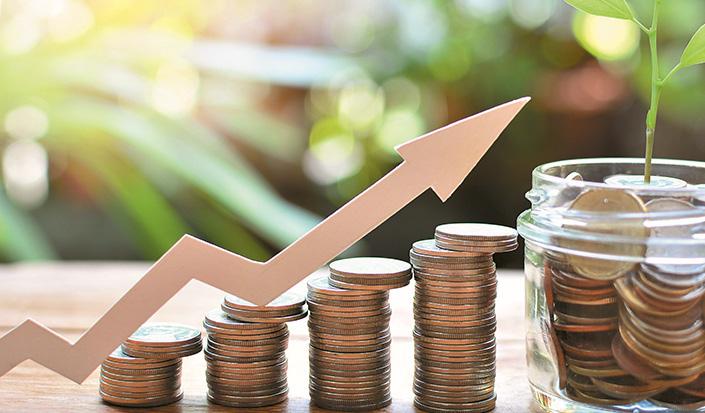
BUSINESS & FINANCE
The $125 million investment from ARC’s Energy Fund 9 includes co-investments by Manulife Financial Corporation, Ontario Power Generation Inc. Pension Plan, CF Private Equity and BDC Capital’s Cleantech Practice. ARC is one of North America’s most established energy-focused private equity fund managers. The latest investment reflects ARC’s continued confidence in Silfab’s ability to meet increasing demand for highquality PV modules through a sustainable growth strategy guided by Silfab’s leadership team and built upon 40 years of experience in the solar industry.
“Silfab is ideally situated to meet North America’s growing appetite for domestically manufactured cutting-edge solar products. ARC remains confident that Silfab will be a driver in clean tech manufacturing and U.S. engineered product innovation. Silfab continues to implement an impressive growth plan built around its unwavering commitment to manufacture high-quality products and its decades of innovation and experience,” said Brian Boulanger, CEO of ARC.
Silfab’s third U.S. solar manufacturing facility is anticipated to be fully operational in 2024 with an initial annual capability of 1 gigawatt cell production and an additional 1.2 gigawatts of PV solar module assembly. Investing in U.S.-made solar cells is a critical component in a clean supply chain to support the manufacturing of solar panels for North American customers. The new facility is expected to generate more than 800 new
U.S. jobs. Other details of the new facility, including location, will be announced at a future date.
“Domestic production of solar cells represents a strategic effort to further manage our supply chain and to apply our technical prowess from the ground up for a comprehensive manufacturing process,” said Paolo Maccario, Silfab’s Chief Executive Officer. “Silfab has grown more than 40 percent since ARC’s initial support. We are thankful for our collaborative relationship with ARC and with the Biden administration and its Inflation Reduction Act, both enabling us to accelerate our U.S. manufacturing strategy. Our growth means more solar jobs for America and reliable energy that customers will use to reduce both costs and their carbon footprint.”

With manufacturing facilities across North America to serve the expanding U.S. market, Silfab utilizes best-in-class automation for ultra-high efficiency module production, leverages partnerships for next-generation technology applications, and offers industry-leading warranties for residential and commercial performance. ARC’s first investment, announced in September 2021, enabled Silfab to make further enhancements to production lines at existing Washington facilities in order to deploy next-generation PV modules to North American consumer, business, and institutional markets. Backed by some of the best warranties in the industry, Silfab manufactures among the most durable, reliable and powerful solar PV modules for the North American residential and commercial markets. Silfab has recorded more than a dozen expansions of production capacity, most recently with state-of-the-art PV module assembly plants in the state of Washington.

www.EQMagPro.com 37 EQ MARCH 2023
Silfab Solar Inc., a North American leader in photo-voltaic (PV) module manufacturing, announced a second investment round led by ARC Financial Corp. (“ARC”) to help fund Silfab’s next expansion of made-in-America manufacturing to include domestic PV cell and module production at a third facility to open in the United States.
CONSORTIUM SIGNS USD 34 BN MOU FOR HYDROGEN PROJECT IN MAURITANIA
German project developer Conjuncta said it signed a memorandum of understanding with Mauritania, Egypt’s energy provider Infinity and the United Arab Emirates’ Masdar for a $34 billion green hydrogen project in the West African country. The project will have a production capacity of up to 8 million tonnes of green hydrogen or other hydrogen-based end products annually, with an electrolyser capacity of up to 10 gigawatts, the company said in a joint statement with the firms involved and the Mauritanian government. Germany has been scrambling to ramp up its renewables capacity to compensate for Russian fuel imports and meet climate targets. In December, Berlin approved the construction of the country’s first hydrogen pipeline network. The first phase of the Mauritania project, to be located northeast of the coastal capital of Nouakchott, should be completed in 2028 with planned capacity of 400 megawatts, it said. The German government and the economy ministry were not immediately available for comment on the agreement.
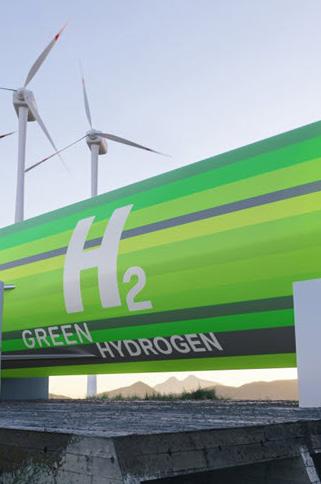
MALAYSIA NEEDS TO INVEST US$375 BILLION IN RENEWABLES TO REACH 2050 CLIMATE GOALS
MALAYSIA will need to double its investments in renewable energy transition to at least US$375 billion in order to achieve its ambitious goal of carbon neutrality by 2050, the International Renewable Energy Agency (Irena) said.
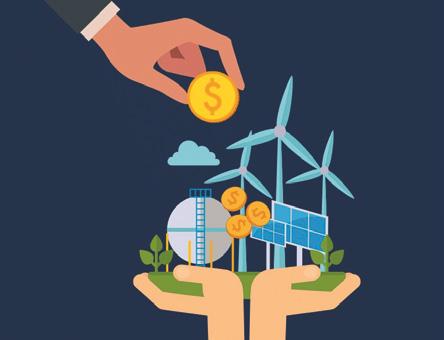
The South-east Asian nation has pledged to cut its greenhouse gas emissions dramatically by 2030 and reach net-zero emissions by 2050. Irena director general Francesco La Camera told Reuters in an interview Malaysia’s planned energy policies could be insufficient to meet its energy transition goals. Due to rising population and energy consumption, Malaysia’s emissions are expected to rise to 280 million tonnes of carbon dioxide per year by 2050, according to an Irena report launched. It currently generates a little over 1 per cent of its electricity annually from renewable sources such as solar and biofuels. Fossil fuels like coal and gas contribute the lion’s share of its power output. Irena said Malaysia needs to increase its total investment to between US$375 billion and US$415 billion, from the current US$159 billion, to expand renewables capacity, infrastructure and energy efficiency. This includes solar energy, wind, hydropower and green hydrogen technologies, and could reduce energy-related emissions by up to 60 per cent. That would also help Malaysia save between US$9 billion and US$13 billion annually in avoided cumulative energy, climate and health costs, and a phasing out of fossil fuel subsidies, Irena said. The investment must also come from private investments and from abroad, including multilateral financial institutions, bilateral and regional arrangements. “There is no doubt that this cannot be done without intense collaboration,” La Camera said.
Source: Reuters Source: Reuters
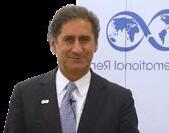
38 EQ MARCH 2023 www.EQMagPro.com
Consortium signs $34 billion MoU for hydrogen project in Mauritania.
BUSINESS & FINANCE
MUUS CLIMATE PARTNERS CLOSES $50 MILLION FUND

Early-stage fund led by climate-focused entrepreneurs and experts seeks to rapidly scale solutions that reduce greenhouse gas emissions
MUUS Climate Partners (MCP), a climate-dedicated venture capital firm, announced the closing of MUUS Convergence Fund II, a $50 million fund focused on impactful companies at the cusp of commercialization. MCP’s Chairman, Michael Sonnenfeldt draws from a decades-long track record of leading and investing in renewable energy companies. In 2016, Sonnenfeldt recruited Partner Ben Wolkon from MIT, to focus exclusively on climate solutions whose impact and return profiles could be accelerated by the application of advanced technology. In Fund II, Sonnenfeldt and Wolkon are joined by a third partner, investor and technologist Logan Grizzel, as well as Principals Laura di Bonaventura, Kavita Patel and Tani Brown. The diverse team leverages a strong track record in climate investing, alongside sector expertise, differentiated viewpoints, and a unique network to identify extraordinary investment opportunities at the intersection of new technologies and decarbonization across the climate tech landscape. MCP’s prior fund, MUUS Convergence Fund I, the $30 million predecessor to Fund II which commenced in 2016, has now surpassed three times the Total Value to Paid-In Capital (TVPI). MCP has been successful in sourcing opportunities in undercapitalized areas of climate tech with outsized potential to reduce emissions. Fund II portfolio companies already include the tech-enabled global renewable power provider BrightNight, the Lawrence Berkeley National Lab spinout Aepnus, and the ultra-low emissions smart heat pump company Harvest Thermal. Because MCP anchored Fund II with internal capital, the team was able to invest in nine companies as the fund was being raised.
MCP uses CRANE to track the emissions reduction potential of every company it invests in. The team also collaborates with the MIT Sloan School of Management Sustainability Initiative and the think tank Climate Interactive to bring the science of climate solutions to political and business leaders.
“In a time when the climate crisis is becoming increasingly urgent, economic conditions are complicating the flow of capital to companies that can most effectively reduce emissions,”
Michael Sonnenfeldt,

Chairman at MCP. “Because of the unique business, academic, and policy networks we’ve built over decades, we have a proven ability to find op- portunities that others have missed or couldn’t access. While we’re proud of our performance, we are even prouder of our companies’ climate impact. Thanks to our collective networks, expertise, and systems, we outperform funds many times our size and help drive success for the entrepreneurs we support.”
“Our group has flown under the radar for years, and during that time we’ve been proud to back some of the most impactful and exciting companies in climate tech and build a strong track record,” said Ben Wolkon, Partner at MCP. “Fund II represents the next phase in our evolution – expanding our world-class team, bringing in extraordinary investment part- ners, and operating a bit more out in the open to highlight the impact of our companies. We couldn’t be more convinced that addressing climate change is this generation’s greatest opportunity for entrepreneurship, innovation and investment.”

VIRAJ PROFILES PARTNERS WITH AVAADA ENERGY TO INSTALL SOLAR POWER PLANT
Stainless steel maker Viraj Profiles said that it has partnered with Avaada Energy to set up a 100MW captive solar plant at Tarapur.
“Viraj Profiles along with Avaada Energy shall set up a Special Purpose Vehicle (SPV) to build a 100 MW captive solar plant,” the company said. In a media statement, the company said that the proposed captive power unit would be commissioned by February 2024. “The power generated will be used for captive consumption by Viraj Profile Limited’s Tarapur plant, whose power dependability on non-renewable resources will be reduced by 50%,” said the statement.


Commenting on the tie-up, Viraj Profiles CMD Neeraj Kochhar said, “We are glad to associate with Avaada Energy Pvt Ltd. Our alliance will work as a catalyst in the process of achieving our sustainability goals towards creating carbon-neutral environment for the future generation. Viraj is the First Stainless Steel Long products manufacturing company in India which is going to use Solar Energy for running its manufacturing plants and operations. This Solar Power project is going to supply 50% of our total monthly electricity requirement,” he further said.
Source: UNI
www.EQMagPro.com 39 EQ MARCH 2023
BUSINESS & FINANCE
BUSINESS & FINANCE
EY AND IBM COLLABORATE TO ADDRESS COMPLEX ESG CHALLENGES AND DRIVE VALUE-LED SUSTAINABILITY


•Help clients manage environmental, social and governance (ESG) matters, work together to build business strategy and demonstrate positive cor relation between purpose and financial performance
•Combine EY and IBM capabilities to help address increasing requirements and help operationalize client improvement programs
T•Integrate technologies to help address the complexities of ESG data volume and types and customer Hybrid IT preferences he EY organization (EY) and IBM (NYSE: IBM) announce a global collaboration to focus on environmental, social and governance (ESG) solutions that aim to help organizations accelerate business transformation with value-led sustainability. EY and IBM teams will pursue innovative offerings that help integrate sustainability with business strategy, support the operationalization of their programs with speed and scale, and transform how value is created for their business, their stakeholders, their people and the planet. EY teams bring extensive experience advising organizations on sustainability strategies and transformation, while IBM offers innovative technology capabilities, and a portfolio of software to measure, deliver and report against sustainability goals. Both industry leaders are working to address the enormous complexities of ESG data by bringing deep understanding of emerging data standards. EY and IBM teams plan to provide offerings orchestrated with leading technologies such as hyperscaler public cloud or ERP systemsof-record. To meet client preferences across diverse hybrid IT landscapes, collaborative offerings are planned to include:
• Scope 3 greenhouse gas emissions accounting and management
• ESG Managed Services
• EY Sustainable Enterprise Asset Management (SEAM) tool for scope 1, 2 and 3 carbon capture, analysis and decision support
This collaboration is expected to leverage the EY organization’s leading Climate Change and Sustainability Services and Technology Consulting practices, along with IBM’s software including the IBM Envizi ESG Suite, IBM Environmental Intelligence Suite, IBM Maximo Application Suite, IBM TRIRIGA Application Suite, IBM Turbonomic Application Resource Management (ARM) and IBM Supply Chain Intelligence Suite, to create a set of frameworks and accelerators to help companies operationalize decarbonization action plans at the asset level. EY and IBM teams are already collaborating in many ways to deliver value-led sustainability, including:
EY SEAM tool, leveraging IBM Maximo Application Suite, helps organizations capture and calculate carbon emissions data, report it according to regulations and set targets to drive action. The tool can be used on any public cloud to support organizations in asset- heavy industries such as civil infrastructure, telecom, energy, mobility and manufacturing. EY Sustainable Travel Approval Tool (STAT), developed in collaboration with IBM Consulting, is designed to encourage employees to book more sustainable travel choices and support an organizations’ carbon ambition by providing users with greater visibility to
both the financial and carbon footprint impact of business travel. Since its launch within the EY organization across 41 markets, the tool has considerably cut one-day travel down from 18% to 3% of total trips, and increased train rail bookings to 36% compared to 10% in FY19, in countries where train rail is a viable option.
Steve Varley, EY Global Vice Chair –Sustainability, says: “In order for organizations to address an ever-evolving set of ESG challenges, solutions must be delivered and deployable at a faster pace than ever before. The value of this deepened and longstanding alliance is in how it leverages the consulting and technology capabilities of both EY and IBM teams, to be at the forefront of how clients plan and accelerate their ESG journey and build trust with their most critical stakeholders.”

Kareem Yusuf, Ph.D., Senior Vice President, Product Management & Growth, IBM Software, says: “A global energy crisis, rising costs and new regulations are among the ongoing and increasing challenges organizations face as they act to deliver upon their sustainability goals while still balancing revenue, risk and driving shareholder returns. IBM’s expanded collaboration with EY is a critical step forward in helping our joint clients accelerate their most pressing sustainability and business objectives.”
This work builds on the EY organization and IBM’s ongoing collaboration including the recent launch of Talent Center of Excellence and the EY-IBM Center of Excellence for Financial Services. Terms and details of definitive agreements to be finalized. Statements regarding IBM’s future direction and intent are subject to change or withdrawal without notice, and represent goals and objectives only.

40 EQ MARCH 2023 www.EQMagPro.com
STERLITE POWER SUCCESSFULLY COMMISSIONS ITS LARGEST GREEN ENERGY CORRIDOR PROJECT IN GUJARAT
• Lakadia-Vadodara transmission project will deliver more than 5000 MW of green and reliable power from the wind and solar energy zones of Bhuj & Kutch to the rest of India
• Crucial part of India’s Green Energy Corridor initiative to help India achieve its RE vision of 500 GW by 2030
Sterlite Power, a leading power transmission company in India and Brazil, announced the successful commissioning of its green energy corridor project – Lakadia-Vadodara Transmission Project Limited (LVTPL). The project aims to deliver more than 5000 MW of power from renewable rich regions of Bhuj and Kutch to the national grid – a step towards accelerating India’s transition towards a greener economy. Built with an investment of Rs 2,024 crore, this inter-state transmission connects the 765/400 kV substation at Lakadia to Vadodara through a 335 km long 765 kV double-circuit transmission line. With 812 towers spanning seven districts in Gujarat, this power transmission corridor is also one of the largest transmission corridors built in India till date. Additionally, it forms a critical part of the world’s largest 30,000 MW Hybrid renewable energy park coming up in Kutch. Commenting on the significant milestone, Pratik Agarwal, Managing Director, Sterlite Power said,” It makes us immensely proud to announce the completion of the mega LVTPL project. It has been a challenging journey, but we have been successful in unlocking 5000 MW of green power for the nation that will accelerate India’s RE vision of 500GW by 2030.”
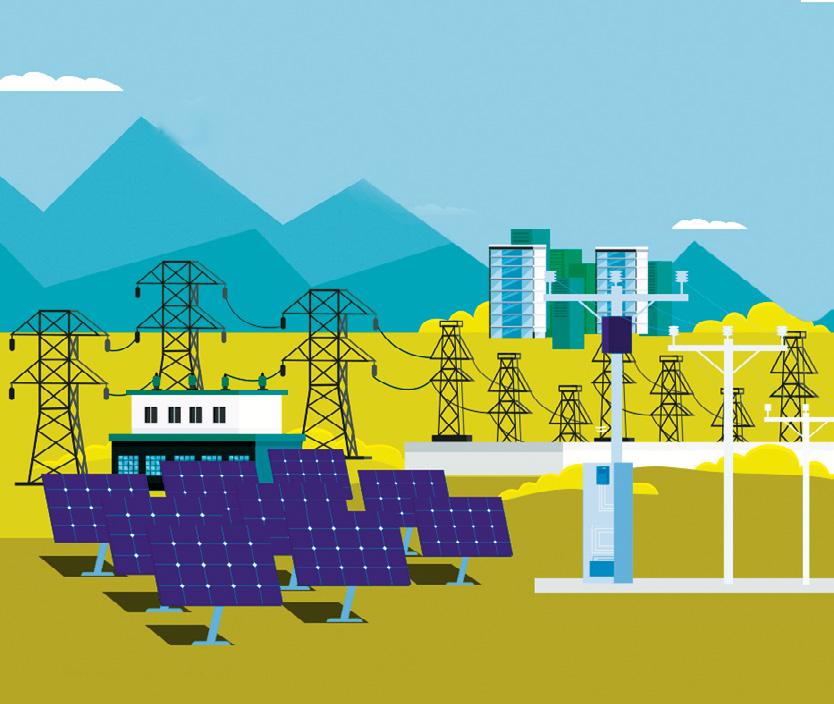
Manish Agarwal, Director & CEO


– India Transmission, Sterlite Power, added, “We are sincerely thankful to the Government and the local administration for their constant support in ensuring the successful completion of the critical project. I am extremely proud of our team and grateful for the trust and support of our stakeholders.”
The project was awarded to the company in 2019 and the work started in 2020, during Covid-19. True to its innovative spirit, the company implemented innovative construction techniques like pocket foundation, well point system, and unique tower designs to construct durable power infrastructure that could withstand the complex terrain challenges in the region. Sterlite Power is known for its sustainable approach to development. During the project execution phase, the company engaged with various communities for an inclusive approach toward development. The company also provided employment to thousands of skilled and unskilled people during the construction phase. It also made concerted efforts to provide essential health items to vulnerable communities around the project sites during the Covid-19 imposed national lockdown.
www.EQMagPro.com 41 EQ MARCH 2023
FEATURED
TATA POWER RENEWABLE ENERGY LIMITED SIGNS PPA FOR 510 MW HYBRID PROJECT WITH TATA POWER DELHI DISTRIBUTION
It is one of the largest hybrid projects in the country with the capacity bifurcation of 170 MW solar & 340 MW wind power
Tata Power Renewable Energy Limited (TPREL), a subsidiary of Tata Power and one of the major renewable energy players in the country, signed a Power Purchase Agreement (PPA) with Tata Power Delhi Distribution Limited (Tata Power-DDL), for 510MW hybrid project. The project will save on an average of 1540 MUs of CO2 emissions annually for Tata Power-DDL, a joint venture between Tata Power and Govt. of Delhi, that supplies electricity to a populace of over 7 million in North Delhi. The PPA has the capacity bifurcation of 170 MW solar and 340 MW wind power. Located in Karnataka, it is one of the largest hybrid projects in the country and will be commissioned within 24 months from the PPA execution date.
Speaking on the signing, Mr. Ashish Khanna, CEO, Tata Power Renewable Energy Limitsaid, “Tata Power Renewable has signed one of the largest PPAs in the country for a 510MW hybrid project, via competitive bidding, showcasing our future readiness and expertise in project execution skills. This partnership is significant in our quest to continue our journey as one of the torchbearers of the green and clean energy transition.”
TPREL won this project through a competitive bidding process, followed by the release of LOA by Tata Power-DDL. This win is an extension of the earlier LOA of 255MW received in Dec. 2022
Mr. Ganesh Srinivasan, CEO, Tata Power Delhi Distribution Limited, added, “Aligned with the nation’s renewable energy mission, we are pleased to join hands with Tata Power Renewable Energy Limited for our biggest hybrid energy tie-up. We are confident that this association will strengthen our commitment towards significantly enhancing the portion of sustainable energy in the overall supply mix.”
With this win, the total renewables capacity of TPREL reaches 6,303MW with an installed capacity of 3,909 MW (Solar – 2,981 MW & Wind – 928 MW) and 2,394MW under various stages of implementation.
INFOSYS LEADS GLOBAL ESG RANKINGS
Top ESG evaluators recognize Infosys’ dedication to sustainability and ethics in business Infosys (NSE, BSE, NYSE: INFY), a global leader in next-generation digital services and consulting, announced it is featured as a top performer across several global industry rankings and assessments in Environmental, Social, and Governance (ESG) in FY22-23. The company has been recognized for its many efforts to consistently demonstrate commitment to sustainability, ethical leadership, and responsible business practices. Infosys topped the charts in the CRISIL ESG Leadership Rankings and was featured in the CRISIL Sustainability Yearbook, 2022 for the second consecutive year. In 2022, the MSCI ESG Assessment also conferred ‘AA’ rating to Infosys. The MSCI ESG ratings measure ESG performance, including the management of financially relevant ESG risks and opportunities, of companies worldwide. Infosys is also a forerunner in driving climate action across its operations. It has been recognized for leadership in corporate transparency and performance on climate change by the global environmental non-profit CDP, securing a place on the CDP annual ‘A List in 2022. This is the seventh year in a row that Infosys has been featured in the leadership category under the CDP Climate Change disclosure – a testament to Infosys’ climate action efforts, including climate-related risk management, mitigation initiatives, transparent disclosures on emissions, and emission reduction initiatives across the supply and value chain. For the sixth year in a row, in 2022, Infosys is listed on the Dow Jones Sustainability Indices (DJSI), a leading benchmark for corporate sustainability. In addition, in their latest Company ESG Risk Ratings, Sus tainalytics recognized Infosys as an industry
-wide and regional top-rated ESG performer in 2023. Sustainalytics is a renowned independent ESG and corporate governance research, ratings, and analytics firm. In 2022, EcoVadis, a globally acclaimed ratings platform for corporate social responsibility and sustainable procurement, recognized Infosys with a Gold med al for CSR practices. Infosys has been a recipient of the EcoVadis Gold recognition for over seven years now.
“With the accelerated progress we are making on the ESG front, the value creation for us across the bottom and top line is solid,” said Nilanjan Roy, Chief Financial Officer, Infosys. “From earning greater client trust and building a purposeful employer brand to making our operations both efficient and sustainable, ESG is integral to our core business strategy. At Infosys, we remain steadfast in our mission to drive responsible business practices.”


ESG is integral to our core business strategy. At Infosys, we remain steadfast in our mission to drive responsible business practices. Infosys’ ESG ambitions are integral to the corporate strategy of creating value for all stakeholders and building a better tomorrow. Check out our latest research report, Infosys ESG Radar 2023, to learn more about how ESG is key to creating business value.

42 EQ MARCH 2023 www.EQMagPro.com FEATURED
EZ4EV TRANSFORMS TO EZURJA, EXPANDS ITS PORTFOLIO TO ENERGY MANAGEMENT
EzUrja envisions full-service energy company with planning and operation of energy production and energy consumption as well as energy distribution and storage
Initiated in the domain of Electric Vehicle infra systems and charging devices, Ez4EV transforms to EzUrja by enlarging its vision in the growing market of energy customers. With the advent of the EV development globally, EzUrja looks upon robust product innovations and effectively maintainable delivery systems. The company ensureslocalized manufacturing and post sales services for stabilizing the EV Charging either static or mobile and ease in delivery riding on full stack software and apps. EzUrja derives itsstrength from its partners, primarily C4V USA, the innovators of the Lithium-Ion new cell chemistry technology which has established a 2 GW manufacturing plant IM3 New York. Under the MOU drawn with EESL way back in 2018, EzUrja got the impetus to develop locally produced EV chargers. Over the past 2 years and continuous R&D with its partners Pyramid Electronics, under its JV EzPyramid Energy. Thus, ensuring committed growth and development to meet the burgeoning EV market and infra requirements. Eventually,limiting heavy imports by localizing the product development and manufacturing from the three plants in India warranting a production capacity of 800 units per month.
Ashhok Kapoor, Director & CBO- EzUrja,“describes this expansion as the outcome of the market growth and stabilization of energy storage sector & increasing EV infra demands. Also, the need of the hour – localization which is a must to meet the customization as well as timely deliveries ensuring robust & quality products.” He further stated, “By providing convenient and reliable charging options, we are helping to make sustainable EV transportation accessible to all.”

EzUrja has designed solutions which shall be soon launched in the market for EV growth in India by fulfilling the gap in infrastructure requirements and the EV buyer concern of range anxiety.Ez4EV mobile EV chargers, equipped with energy storage and a bank of AC & DC fast chargers to meet the requirements of 2W, 3W to e-busses and soon to see commercial e-vehicles. Based on app booking, full EV charging anywhere – anytime. With the Pollution Control Board ensuring maintenance of clean environment, Delhi has been given its date to discontinue diesel generator sets which need appropriate options. EzEnergy as a solution has been designed as customized energy storage packaged with lithium-ion batteries capable of 1 hour to 4 hour back-ups or more as per the consumption demands. The company has been successfully offering convenient, reliable, and safer charging solutions to provide efficient energy systems and clean mobility available and accessible for all. With this step, the company has further strengthened its commitment to providing “easy power anywhere” and to meet the growing demands of the burgeoning EV industry and energy needs inIndia and products to meet global demands.
ENERGY HAS BID FOR PRODUCTION LINKED INCENTIVE (PLI) SCHEME

Grew Energy Pvt Ltd was successful in its bid under the second tranche of the Production Linked Incentive (PLI) scheme for solar modules. Only 11 out of thousands of companies in India submitted bids for Tranche-II of the PLI scheme. This will help create a healthy ecosystem for sourcing essential materials for the solar industry that are also Made-in-India.
Mr. Vinay Thadani, Director of Grew Energy Pvt Ltd, said, “The PLI program under the ‘National Program on HighEfficiency Solar Modules’ will give a tremendous boost to Indian manufacturers to make high-efficiency solar modules. This also comes at a time when India has set ambitious net-zero targets and has witnessed a steep rise in energy demand. Achieving a gigawatt-scale manufacturing capacity for high-efficiency solar modules will subsequently reduce dependency on imports and boost the Indian economy.”
Grew Energy is tapping into this incredible opportunity and has ventured into manufacturing for the solar sector in addition to offering EPC solutions. Over the next four years, their manufacturing facility will reach a capacity of producing 4 GW of PV modules, 3 GW of PV cells, 2GW of Ingot & Wafers and 300 tonnes/day of tempered glass. Initially, their manufacturing will start with a 2-GW fully automated unit in Rajasthan, while more facilities will be established across India in a phased manner. Grew intends to work persistently towards gradually making India a leader in exports of PV Modules and other components, moving away from dependency on imports.
www.EQMagPro.com 43 EQ MARCH 2023
GREW
Aims to reduce India’s import dependency for solar modules
FEATURED
EMBODIED CARBON MANAGEMENT FOR GLOBAL INFRASTRUCTURE

Embodied carbon management for global infrastructure.
EXECUTIVE SUMMARY
The coming three decades will witness the global construction industry surpassing USD30 trillion annually from the current spending of around USD11 trillion1. Research suggests that every billion dollars spent on infrastructure development generates one million tons of embodied carbon, due to the prevailing practices of designing, procuring, and constructing capital projects. This emission factor is amplified three times during the asset operations and maintenance phase in the form of operational carbon emission. Substantial emphasis has been given to the reduction of operational carbon through energy efficiency measures, government policies, corporate initiatives, and carbon offset strategies. However, the inherent problem associated with embodied carbon remains to be tackled in a structured manner. This need becomes not only more important but urgent at a global scale, as the share of embodied carbon from construction projects and infrastructure assets in the next two to three decades will be equivalent to their operational carbon emissions. As embodied carbon remains throughout the asset life, the infrastructure projects have to be executed ‘right the first time with carbon consciousness, having a limited path to return’. Despite this, few countries with highest construction spend and growth rate are yet to act in firming up policies and centralised measures for curbing embodied carbon. The construction industry is amongst the slowest to adapt and evolve, be it technological advancements, productivity improvements, or manpower skilling. With the rapid pace of urbanisation and ageing infrastructure replacement, projects are needed to be built at a much faster rate, which makes the problem at hand more challenging for reducing the carbon footprint this sector will generate. Evidently, direct solutions for embodied carbon management are limited but existing digital penetration can play a pivotal role in this area by leveraging tools and platforms currently in use such as Building Information Modeling (BIM), digital twin, and Common Data Environment (CDE) amongst others. A collective approach towards whole lifecycle carbon management of capital projects will need to be the way forward for global infrastructure. It is imperative for the global construction industry to collaborate and address this challenge of embodied carbon reduction.
The coming three decades will witness the global construction industry surpassing USD30 trillion annually from the current spending of around USD11 trillion1. Research suggests that every billion dollars spent on infrastructure development generates one million tons of embodied carbon, due to the prevailing practices of designing, procuring, and constructing capital projects. This emission factor is amplified three times during the asset operations and maintenance phase in the form of operational carbon emission. Substantial emphasis has been given to the reduction of operational carbon through energy efficiency measures, government policies, corporate initiatives, and carbon offset strategies. However, the inherent problem associated with embodied carbon remains to be tackled in a structured manner. This need becomes not only more important but urgent at a global scale, as the share of embodied carbon from construction projects and infrastructure assets in the next two to three decades will be equivalent to their operational carbon emissions. As embodied carbon remains throughout the asset life, the infrastructure projects have to be executed ‘right the first time with carbon consciousness, having a limited path to return’. Despite this, few countries with highest construction spend and growth rate are yet to act in firming up policies and centralised measures for curbing embodied carbon. The construction industry is amongst the slowest to adapt and evolve, be it technological advancements, productivity improvements, or manpower skilling. With the rapid pace of urbanisation and ageing infrastructure replacement, projects are needed to be built at a much faster rate, which makes the problem at hand more challenging for reducing the carbon footprint this sector will generate. Evidently, direct solutions for embodied carbon management are limited but existing digital penetration can play a pivotal role in this area by leveraging tools and platforms currently in use such as Building Information Modeling (BIM), digital twin, and Common Data Environment (CDE) amongst others. A collective approach towards whole lifecycle carbon management of capital projects will need to be the way forward for global infrastructure. It is imperative for the global construction industry to collaborate and address this challenge of embodied carbon reduction.

44 EQ MARCH 2023 www.EQMagPro.com FEATURED
DECONSTRUCTING THE PROBLEM OF EMBODIED CARBON2,3,4,5
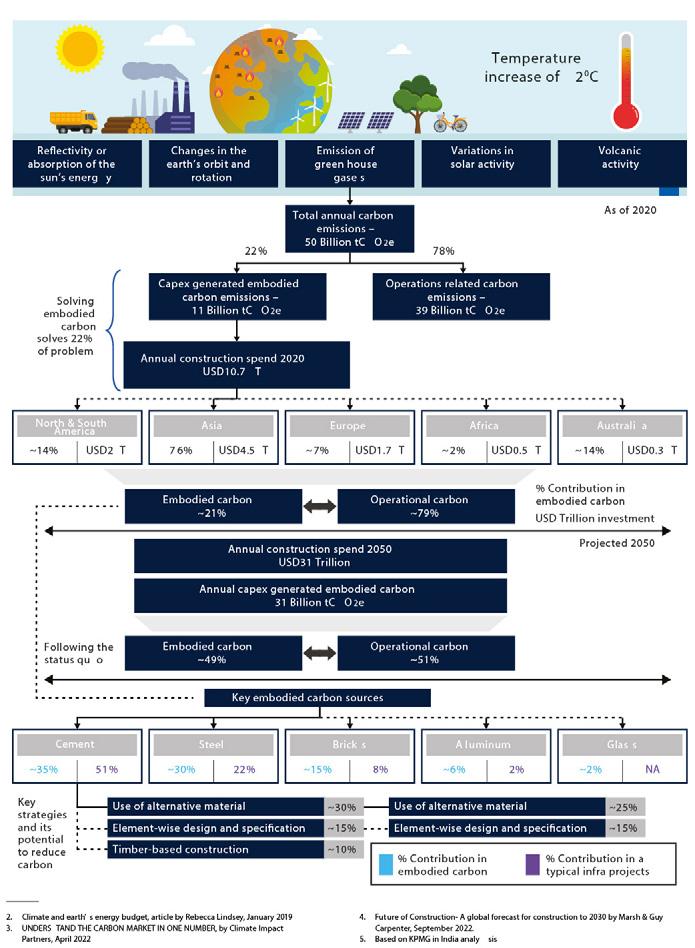
www.EQMagPro.com 45 EQ MARCH 2023 FEATURED
FOREWORD

The COP27 has been a grim reminder for all nations' concerted efforts in the current decade for reducing the carbon emissions and keeping the global temperature increase below 1.5 degree Celsius. With climate change becoming a pervasive issue, infrastructure development also has its fair share to resolve when it comes to carbon emissions from capital projects. With the burgeoning global infrastructure spending, focused and impending actions are warranted from the construction industry. In this quest to build rapid infrastructure for global growth, we cannot not miss the carbon implications it brings, in the form of embodied and operational carbon emissions. Today, the global construction industry accounts for a greater share of embodied carbon as compared to the overall transportation sector. In the coming few years, construction sector growth is also expected to surpass that of manufacturing sector by contributing to almost one-third of global GDP.
At such a scale, addressing embodied carbon becomes existential for the infrastructure sector and its stakeholders including the feeding industries such as steel, cement, aluminum, and others. Project developers and asset owners embarking on their decarbonisation and/or net zero journeys should consider emissions generated from embodied carbon while finalising design and procurement decisions.



46 EQ MARCH 2023 www.EQMagPro.com
FEATURED
Mr. Anish De Global Head Energy, Natural Resources and Chemicals (ENRC)
Mr. Yash Pratap Singh Partner Business Consulting
TABLE OF CONTENTS

www.EQMagPro.com 47 EQ MARCH 2023 FEATURED
INCREASING TEMPERATURE DUE TO EMBODIED CARBON AN IMMINENT PROBLEM TO SOLVE 1.1 EXPECTED TEMPERATURE INCREASE
The global population recently crossed 8 billion mark and is estimated to be approximately 9.7 billion by 20506. Consequently, large-scale addition of urban and infrastructure development such as buildings, factories, warehouses, airports, ports, etc., will be required over the next three decades. This may lead
to an increase in upfront carbon emissions equivalent to ~ 11 billion tCO2e annually. Without stricter controls and actions around infrastructure development, we may face more than 100 gigatons of embodied carbon emissions by 2050, leading to a global temperature increase of more than 2oC.7

48 EQ MARCH 2023 www.EQMagPro.com
FEATURED
1.2 IMPORTANCE OF MANAGING EMBODIED CARBON

From 2020 to 2050, embodied carbon will be responsible for almost half of the new construction emissions9. Unlike operational carbon, which can be reduced over time with energyefficient measures and renewable energy sources, embodied carbon emission is generally locked in once the asset is built. While there are existing standards and initiatives taken to reduce operational carbon, only a few of the global assets being developed have considered the Whole Lifecycle Carbon Assessment (WLCA).
From 2020 to 2050, embodied carbon will be responsible for almost half of the new construction emissions9. Unlike operational carbon, which can be reduced over time with energyefficient measures and renewable energy sources, embodied carbon emission is generally locked in once the asset is built. While there are existing standards and initiatives taken to reduce operational carbon, only a few of the global assets being developed have considered the Whole Lifecycle Carbon Assessment (WLCA).
www.EQMagPro.com 49 EQ MARCH 2023 FEATURED
FEATURED
1.3 POTENTIAL TO REDUCE EMBODIED CARBON
Continuous efforts towards localisation and self-reliance in major economies are resulting in new asset development in infrastructure sectors such as roads, buildings, and manufacturing. These sectors are key sources of carbon emissions not only during the asset operations phase but also its development phase. For example, the world will add 2.4 trillion sq. ft of new floor area in the building sector, equivalent to adding an en
tire New York City every month for 40 years.11 Currently, the world emits ~ 50 billion tCO2e of carbon emissions annually, of which, ~ 11 billion tCO2e (22 per cent) comes from embodied carbon emissions from new infrastructure and building development. Through improved planning, design, and procurement decisions, we have an immediate opportunity to curtail ~ 5 billion tCO2e embodied carbon emissions (roughly 45 per cent of total annual embodied carbon emission)
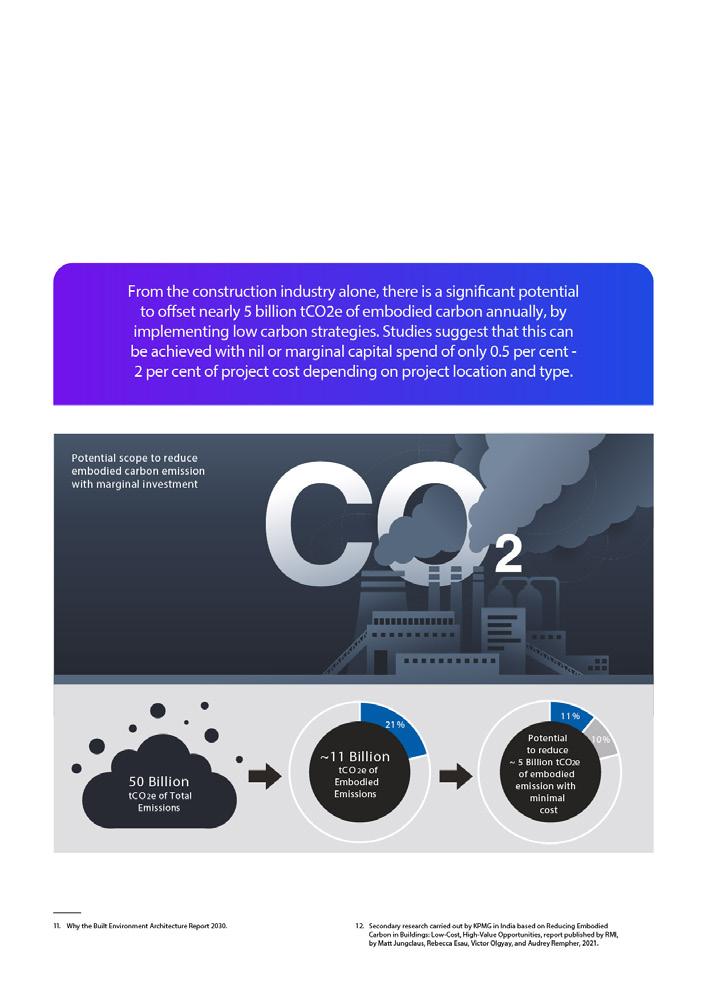
50 EQ MARCH 2023 www.EQMagPro.com
CONSTRUCTION INDUSTRY - MAJOR CONTRIBUTOR TO GLOBAL WARMING
2.1 EXPECTED GROWTH IN THE GLOBAL CONSTRUCTION INDUSTRY BY 2050
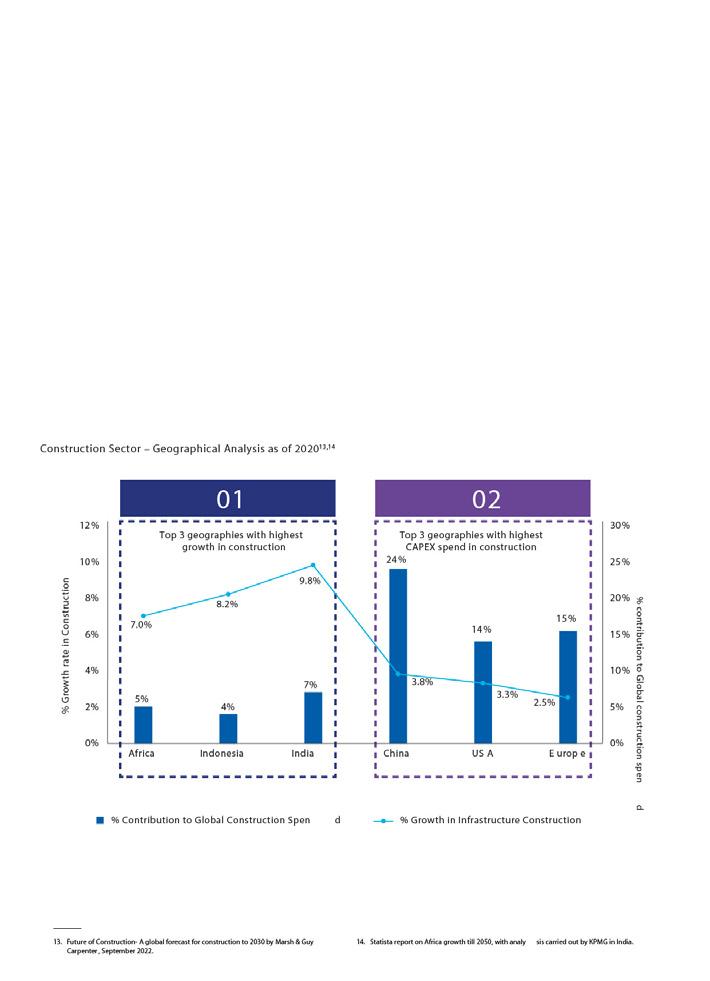
The global construction industry is expected to grow from USD10 trillion in 2022 to USD34 trillion by 2050, with a CAGR of ~four per cent. It is expected to surpass the manufacturing sector in the current decade, with its estimated growth to reach around 29 per cent of the global GDP. This includes the construction of new assets as well as the restoration and renovation of aged infrastructure assets that make up about 25 per cent of the overall construction industry. India, China, the U.S., and Indonesia stand out in the global construction landscape
with a 58 per cent share of total construction activity. Moreover, the construction sector in India, Africa, and Indonesia will grow at eight to ten per cent CAGR, making these geographies ripe for embodied carbon reduction by taking immediate measures.13 Meanwhile, economies such as the USA, China, and Europe, with a vast asset pool already in place, may instead explore opportunities for restoration and renovation. Overall, the strategy to reduce embodied carbon will be unique to the infrastructure growth in the respective country.
INDIA, INDONESIA, AND AFRICA HAVE RELATIVELY SUBSTANTIAL OPPORTUNITIES TO REDUCE EMBODIED CARBON, GIVEN THE GROWTH POTENTIAL IN THEIR CONSTRUCTION SECTOR.
ON THE OTHER HAND, MORE THAN 50 PER CENT OF CAPITAL PROJECTS WILL BE BUILT IN LARGE ECONOMIES, ALLOWING THEM TO SET GLOBAL CARBON REDUCTION STANDARDS FOR OTHERS TO FOLLOW.
www.EQMagPro.com 51 EQ MARCH 2023 FEATURED
01
02
FEATURED
2.2 KEY ACTIONS UNDERTAKEN15
The opportunity to address carbon reduction is maximum in countries with the relatively higher infrastructure growth in the next 30 years. However, such geographies require increased
efforts towards centralised or standardised policies for embodied carbon emissions from the construction industry.

52 EQ MARCH 2023 www.EQMagPro.com
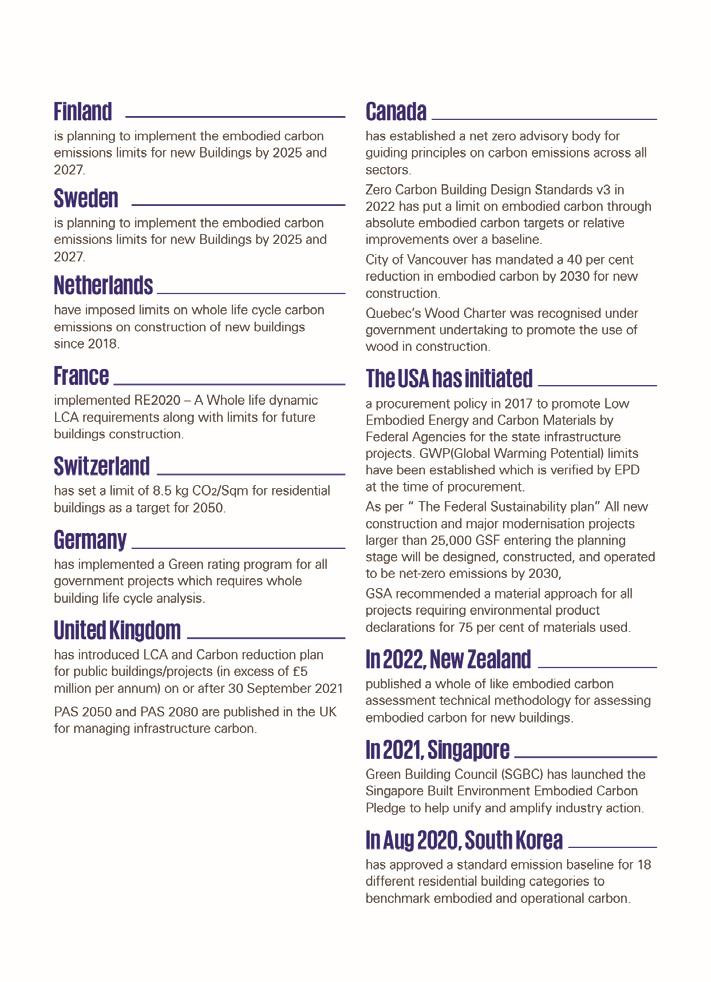
www.EQMagPro.com 53 EQ MARCH 2023 FEATURED
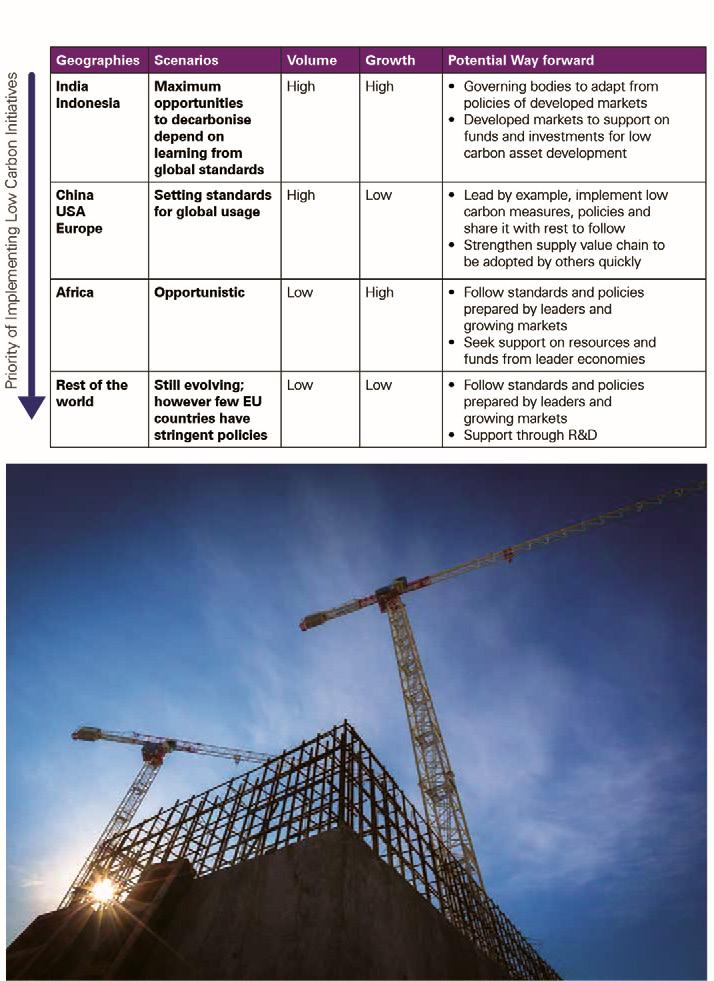
54 EQ MARCH 2023 www.EQMagPro.com
FEATURED

www.EQMagPro.com 55 EQ MARCH 2023 FEATURED

56 EQ MARCH 2023 www.EQMagPro.com
FEATURED

www.EQMagPro.com 57 EQ MARCH 2023 FEATURED
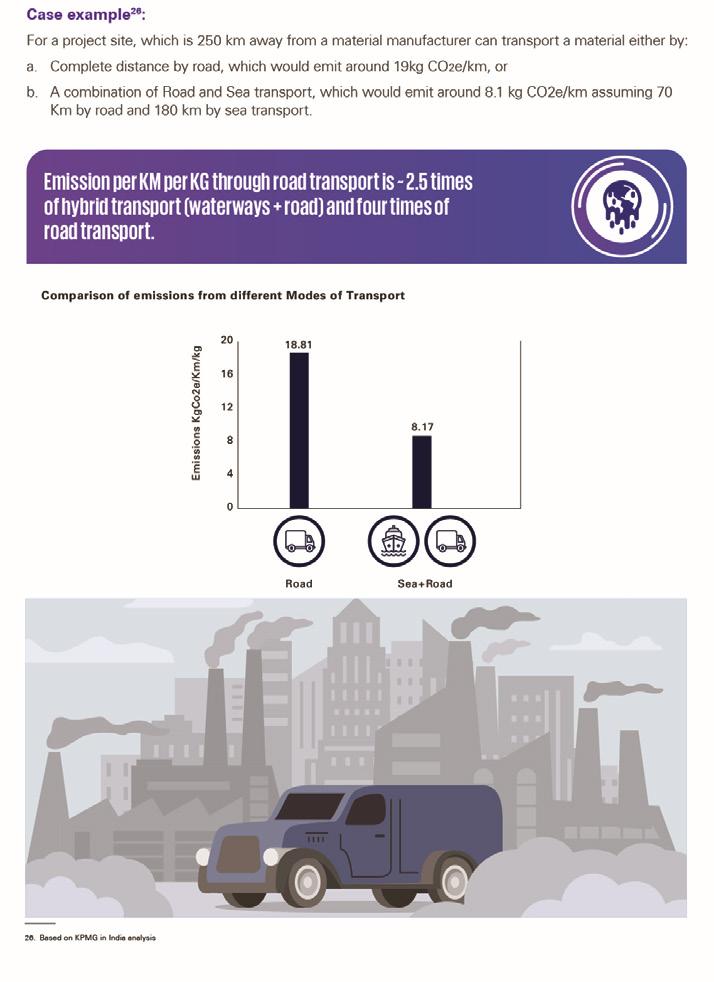
58 EQ MARCH 2023 www.EQMagPro.com
FEATURED
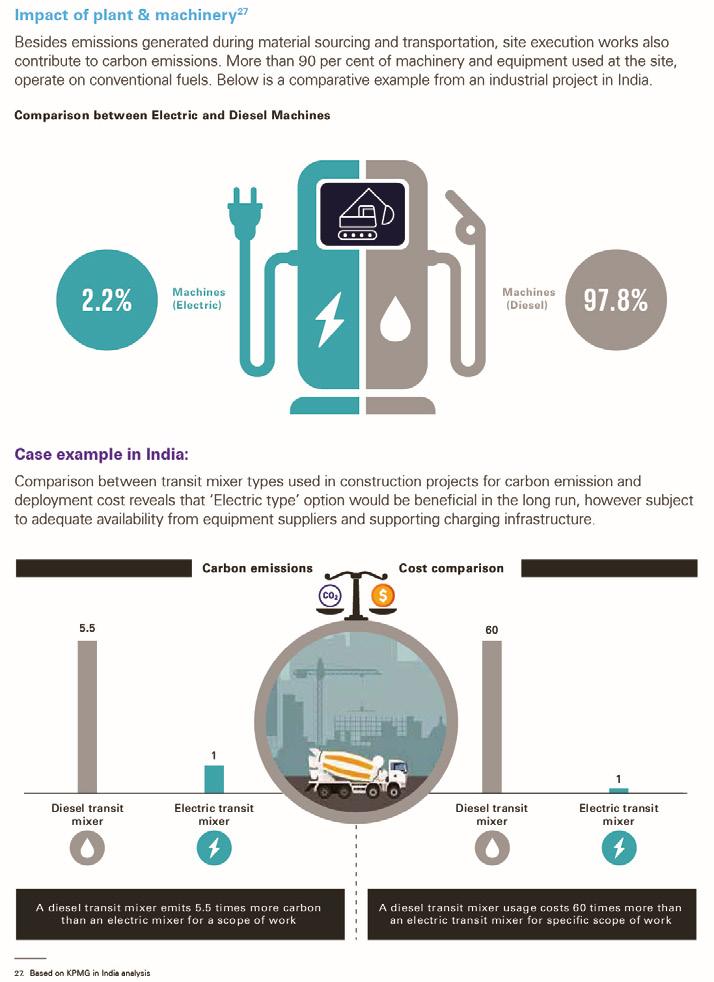
www.EQMagPro.com 59 EQ MARCH 2023 FEATURED
FEATURED
SOLUTIONS FOR EMBODIED CARBON

60 EQ MARCH 2023 www.EQMagPro.com

www.EQMagPro.com 61 EQ MARCH 2023 FEATURED
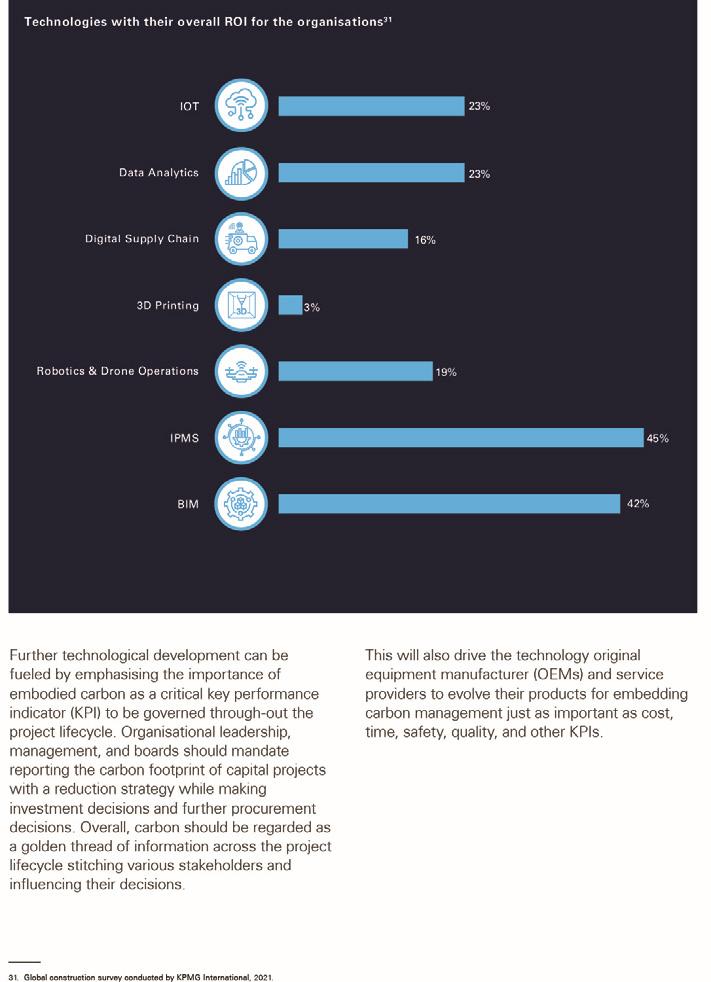
62 EQ MARCH 2023 www.EQMagPro.com
FEATURED

www.EQMagPro.com 63 EQ MARCH 2023 FEATURED
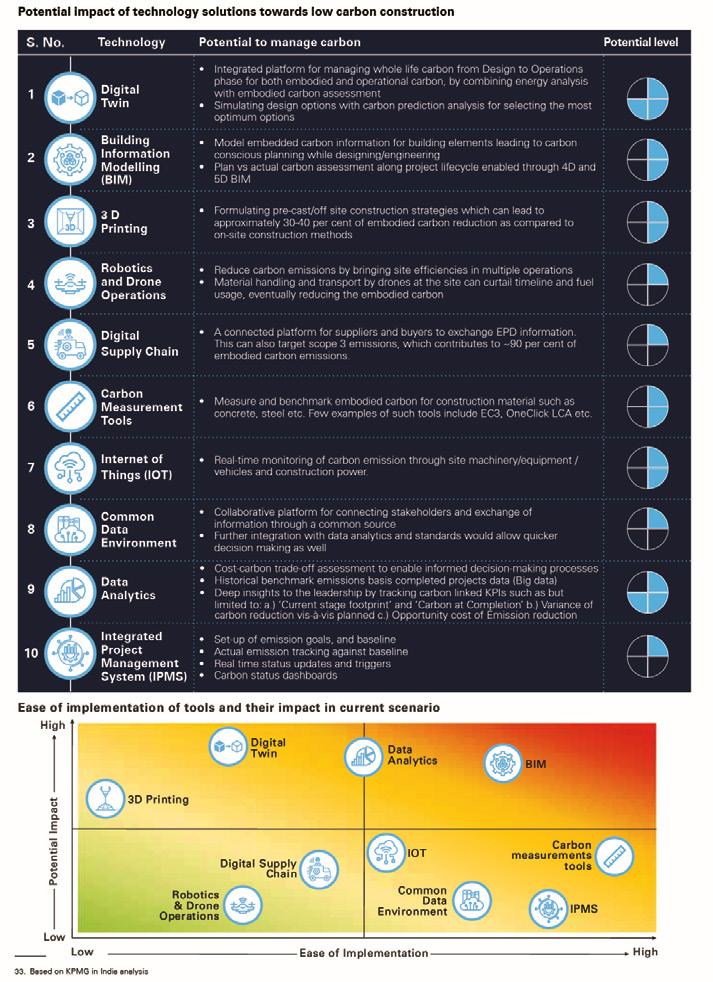
64 EQ MARCH 2023 www.EQMagPro.com
FEATURED
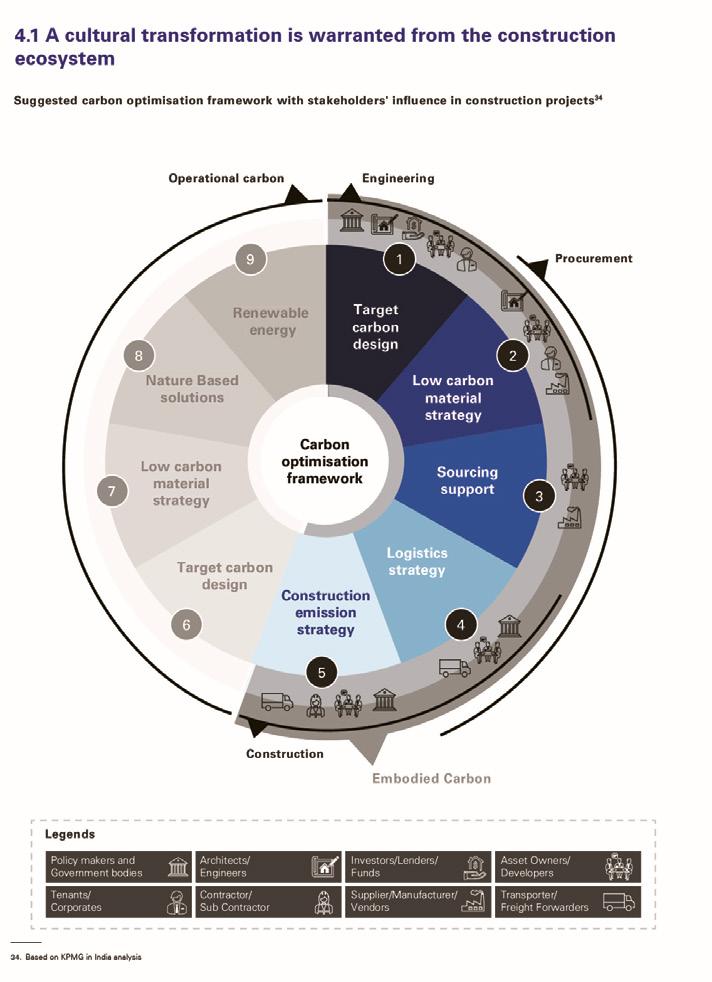
www.EQMagPro.com 65 EQ MARCH 2023 FEATURED
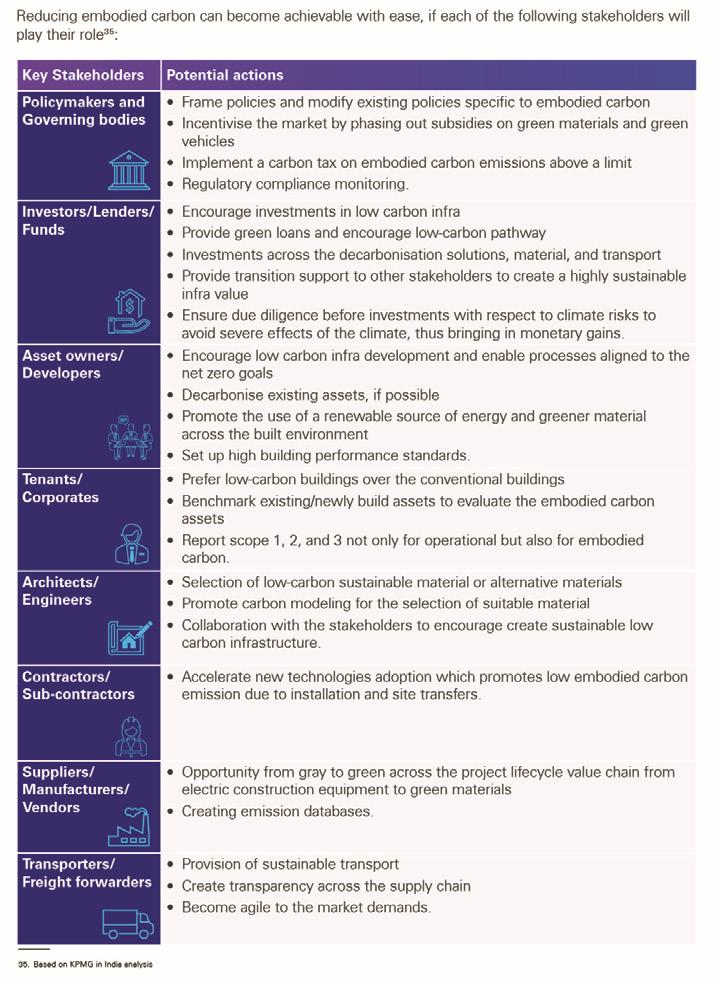
66 EQ MARCH 2023 www.EQMagPro.com
FEATURED
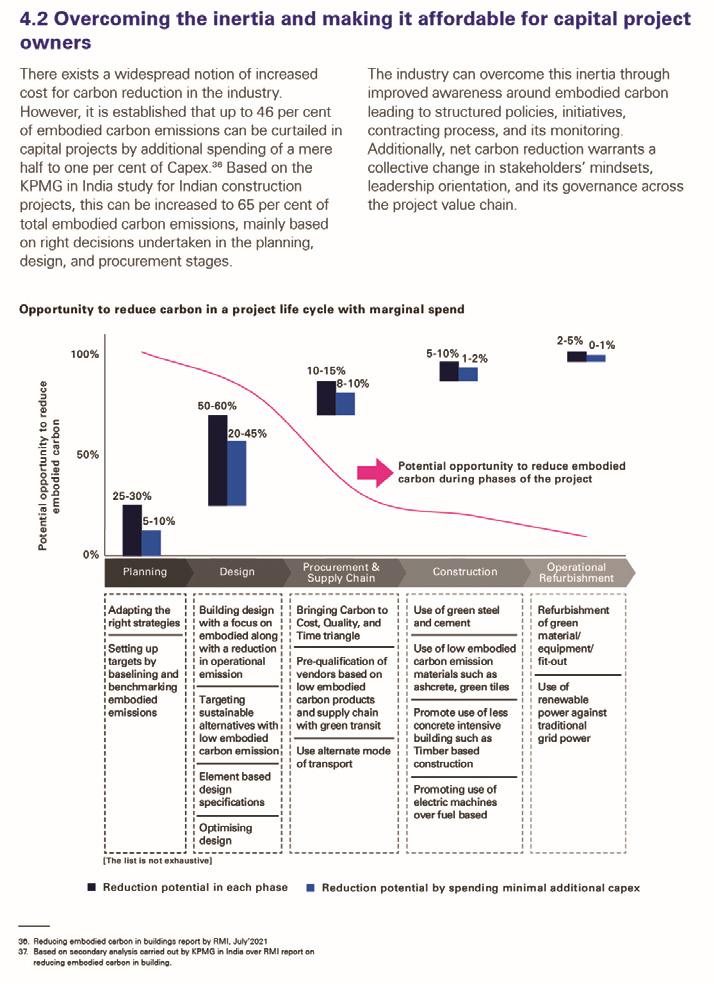
www.EQMagPro.com 67 EQ MARCH 2023 FEATURED
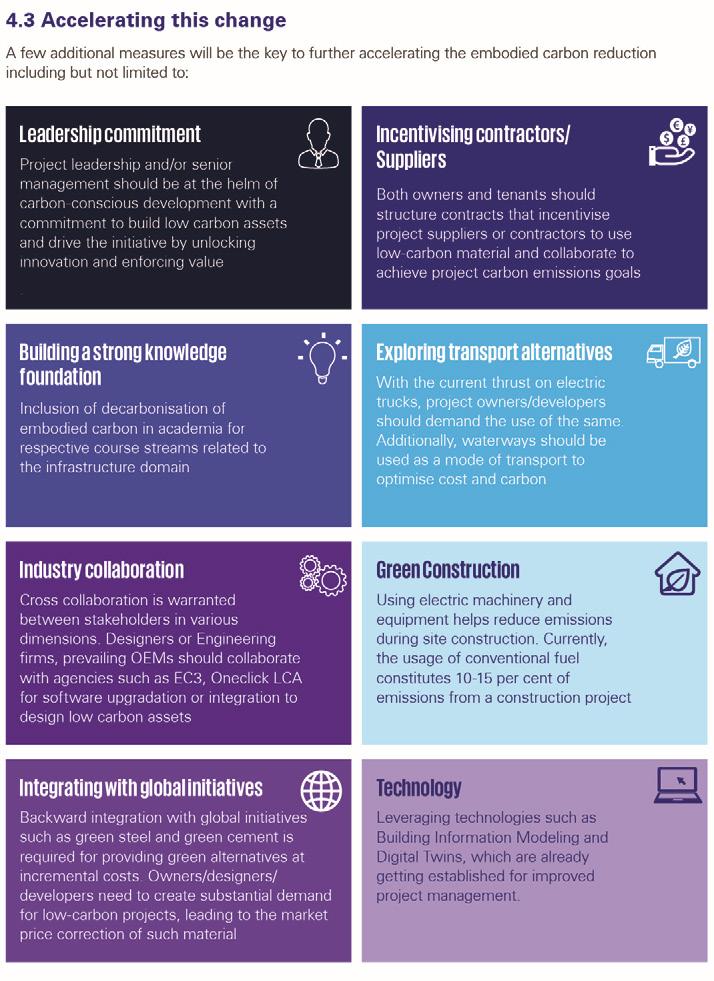
68 EQ MARCH 2023 www.EQMagPro.com
FEATURED
CONTROLLING ELECTRIC DOUBLE LAYER DYNAMICS FOR NEXT GENERATION ALL-SOLID-STATE BATTERIES
Researchers achieve carrier modulation and improved switching response speed control in these batteries

Development of all-solid-state batteries is crucial to achieve carbon neutrality. However, their high surface resistance causes these batteries to have low output, limiting their applications. To this end, researchers have employed a novel technique to investigate and modulateelectric double layer dynamics at the solid/solid electrolyte interface. The researchers demonstrate unprecedented control of response speed by over two orders of magnitude, a major steppingstone towards realization of commercial all-solid-state batteries. In our quest for clean energy and carbon neutrality, all-solid-state lithium-ion batteries (ASS-LIBs) offer considerable promise.ASS-LIBs are expected to be used in a wide range of applications including electric vehicles (EVs).However, commercial application of these batteries is currently facing a bottleneck—their output is reducedowing to their high surface resistance.Moreover, the exact mechanism of this surface resistance is hitherto unknown. Researchers have alluded it to a phenomenon called the “electric double layer” (or EDL) effect seen in colloidal substances (which are microscopic dispersions of one kind of particle in another substance). The EDL effect occurs when colloidal particles gain negative electric charge by adsorbing the negatively charged ions of the dispersion medium on their surface.“This occurs at the solid/ solid electrolyte interface, posing a problem in all-solid-state lithium batteries,”explains Dr. Tohru Higuchi, Associate Professor at Tokyo University of Science (TUS). Dr. Higuchi, along with colleagues Dr. Makoto Takayanagi from TUS, and Dr. Takashi Tsuchiya and Dr. Kazuya Terabe from National Institute for Materials Science in Japan, has devised a novel technique to quantitatively evaluate the EDL effect at the solid/ solid electrolyte interface. An article detailing their technique was made available online on 8 February 2023 and was published in Volume 31 of Materials Today Physics.The researchersemployed an all-solid-state hydrogen-terminated diamond (H-diamond)-based EDL transistor (EDLT) to conduct Hall measurements and pulse response measurements that determined EDL charging characteristics. By inserting a nanometerthick lithium niobate or lithium phosphate interlayer between the H-diamond and lithium solid electrolyte, the team could investigate the electrical response of the EDL effect at the interface between these two layers.The electrolyte’s composition did, indeed, influence the EDL effect in a small region around the electrode interface. The EDL effect was reduced when a certain electrolyte was introduced as an interlayer between the electrode/solid electrolyte interface. EDL capacitance for the lithium phosphate/H-diamond interface was much higher compared to the lithium niobate/H-diamond interface. Their article also explains how they improved the switching response time for charging ASS-EDLs. “The EDL has been shown to influence switching properties, so we considered that the switching response time for charging ASS-EDLs could be greatly improved by controlling the capacitance of the EDL. We used the non-ion-permeable property of diamond in the electron layer of
the field-effect transistor and combined it with various lithium conductors,” Dr. Higuchi narrates.
The interlayer accelerated and decelerated the EDL charging speed. The electrical response time of the EDLT was highly variable—it ranged from about 60 milliseconds (low speed switching for lithium phosphate/H-diamond interface) to about 230 microseconds (high speed switching for lithium niobate/Hdiamond interface). The team, however,exhibited control over the EDL charging speed for over two orders of magnitude. In summary, the researchers were able to achieve carrier modulation in all-solid-state devices and improved their charging characteristics.“These results from our research on the lithiumion conductive layer are important for improving the interface resistanceand may lead to the realization of all solid-state batteries with excellent charge-discharge characteristics in the future”,notes an optimistic Dr. Higuchi. Taken together, this is a major steppingstone towards controlling the interface resistance of ASS-LIBs that catalyzes their feasibility for many applications. It will also help design better solid-electrolyte-based devices, a class of gadgets which also includes neuromorphic devices.

www.EQMagPro.com 69 EQ MARCH 2023 FEATURED
ELECTRIQ POWER SECURES $300 MILLION FOR SOLAR+STORAGE FINANCING


New agreement ensures access to zero-up-front-cost, clean energy systems for homeowners across California
Electriq Power (Electriq), a provider of intelligent energy storage and management for homes and small businesses, announced today it has entered into a multi-year agreement with a major U.S. clean-energy company. The provider company, founded by one of the largest investors in clean energy infrastructure, provides a platform that designs, proposes and finances solar and storage projects nationwide. The financing is estimated to be greater than $300 million over 30 months, based on expected sales volumes, system size, and pricing contained in the agreement. The companies will jointly provide operations including potential grid services over 25 years. The financing will support the implementation of Sustainable Community Networks (SCNs) throughout California.
Electriq Power offers turnkey energy solutions that include everything needed for home energy independence – solar panels, batteries, software, project development, financing, installation and grid services – all with zero upfront costs. Electriq’s energy systems are available to homeowners in select geographic locations, regardless of income or credit history, including low- and moderate-income households. No credit checks or property liens are required. By connecting organizations, companies, cities and municipalities, and their local homeowners into Sustainable Community Networks, Electriq Power is enabling a shared vision of making the planet a better place. Through these collaborations, as well as by providing a comprehensive solution portfolio, Electriq Power makes it possible to deliver complete, clean, affordable, and resilient energy to all homeowners.
Rising utility rates, ever-increasing occurrences of power outages, and growing customer interest in decarbonizing is driving market growth for solar and energy storage solutions. Solar installations are projected to grow 15 percent per year, even before the potential impact of rebates, tax credits, and subsidies in the recently enacted Inflation Reduction Act (IRA).

We believe Electriq Power’s comprehensive solution, which includes home storage systems in addition to solar, will play a major role in post-NEM 3 deployments, allowing customers to store energy generated by the solar panels and use it at times when utility rates are high or during power outages.
This agreement is a key milestone in the availability of secure, affordable, and predictable energy to households across California, said Frank Magnotti, Chief Executive Officer, Electriq Power. “We are excited to join forces with a major U.S. clean-energy company that brings together finance and technology, to provide customers with an all-in-one solution for powering their carbon-neutral homes, and to continue our efforts in delivering SCN’s across California. Our provider’s expertise in the energy sector and their software platform will enable us to jointly provide potential grid services and expand access to more communities. This agreement is a win for cities and municipalities throughout California and, most importantly, for their residents.”
70 EQ MARCH 2023 www.EQMagPro.com ENERGY STORAGE
GOV. JUSTICE ANNOUNCES OUR NEXT ENERGY (ONE) TO BUILD BATTERY STORAGE SYSTEM MANUFACTURING FACILITY IN JACKSON COUNTY; CREATE OVER 100 NEW JOBS
Gov. Jim Justice announced today that Our Next Energy (ONE), a Michigan-based energy storage technology company, has entered into an agreement with the State of West Virginia to locate its Aries Grid battery storage system manufacturing facility in Ravenswood, at the Berkshire Hathaway Energy Renewables (BHE Renewables) microgrid business site.






ONE will use a 40,000 sq. ft. industrial building already located on the Ravenswood site to assemble Aries Grid, a lithium iron phosphate (LFP) utility-scale battery system that can serve as long-duration energy storage. Millwood is an ideal location to build Aries Grids as BHE Renewables selected ONE as its partner for utilityscale battery storage at its microgrid business site. With today’s announcement, the Aries Grid battery will be manufactured in West Virginia.
Today’s announcement is a proud day for all West Virginians, Gov. Justice said. “We’re welcoming ONE to West Virginia with open arms, and we’re continuing to celebrate our ability to compete and attract world-class businesses to our great state. The Aries Grid battery storage system manufacturing facility enables hardworking West Virginians to continue their legacy producing America’s energy, and I couldn’t be more excited for ONE to build their new home in Almost Heaven, West Virginia.”
ONE’s plans for a factory to build its Aries Grid battery storage systems in Jackson County is another exciting opportunity for West Virginia that is a direct result of the Inflation Reduction Act, said Senator Manchin. “This investment will provide good-paying jobs, help onshore battery supply chains and boost American manufacturing. Our state is just beginning to realize the benefits of the Inflation Reduction Act and Bipartisan Infrastructure Law, and I can’t wait to see the Mountain State continue our legacy as America’s energy powerhouse.”
Our Next Energy opening their newest battery storage factory in West Virginia is a big win for our state, said Congresswoman Miller. “Their collaboration with established businesses as well as the federal government will result in economic growth, job creation, and energy production. I applaud their state-of-the-art technology that will accelerate West Virginia’s standing as a leader in energy micro-powered manufacturing.”
The BHE Renewables microgrid project, estimated at 420 MWh, in Jackson County represents a historic transition to renewable energy-based manufacturing in the U.S. and establishes a standard for others to follow,” said Mujeeb Ijaz, CEO and Founder of ONE. “Building upon BHE Renewables’ commitment to this site and the State of West Virginia, ONE’s first Aries Grid factory will bring even more jobs and investment to this area to help clear a path to a carbon-free manufacturing future.”
This is a shining example of the continued momentum that innovative, outstanding businesses are finding in West Virginia, said Mitch Carmichael, Secretary of the West Virginia Department of Economic Development. “We are thrilled that ONE said “yes” to West Virginia and are excited to welcome ONE to be a part of the future of the energy industry, our state, the nation and the world.”
ONE’s announcement of additional investment in Jackson County shows West Virginia’s increasing role as a leader in the energy and manufacturing sectors, and I thank Mujeeb Ijaz for recognizing all that our state has to offer, said Senator Capito. “This development serves as one more example of our state’s commitment to job creation and economic development that will result in positive change and growth for generations to come.”
ONE expects the manufacturing facility to be operational in 2025, with hiring to start next year. In Sept. 2022, Gov. Justice announced that BHE Renewables entered into an agreement with the State of West Virginia to purchase more than 2,000 acres of land in Ravenswood, West Virginia, to be developed as a first-of-its-kind renewable energy microgrid-powered industrial site. The West Virginia Economic Development Authority is working with BHE Renewables to bring additional businesses to the site to take advantage of the prime manufacturing location and renewable energy infrastructure.
www.EQMagPro.com 71 EQ MARCH 2023 ENERGY STORAGE
Source: wvnews
SMARTVILLE TAKES MAJOR STEP FORWARD WITH MOAB™, ITS SCALABLE, SECOND-LIFE ENERGY STORAGE SYSTEM INSTALLED FOR UC SAN DIEGO




Smartville, a leading developer of reliable second-life energy storage systems, has deployed its first commercially available product, the MOAB™ energy storage system, at the University of California San Diego’s Library Annex.

MOAB is the first secondlife energy storage system to integrate and control repurposed electric vehicle battery packs from different manufacturers at varying levels of health in one unified system. By giving EV batteries a second life as ultra-low carbon storage with a high value per kilowatt hour and assured reliability, Smartville is bringing the U.S. closer to energy independence and the planet closer to a net-zero future. UC San Diego uses Smartville’s MOAB system to store solar energy from a 200-kilowatt rooftop solar array to reduce demand on the local utility grid after sunset and avoid peak electricity rates. The 500-kilowatt-hour system also provides 48 hours of emergency backup power.
Smartville’s technology, which fills a very important role in the clean energy mosaic, is exactly what California needs, said David Hochschild, chair of the California Energy Commission at the project unveiling. “This new technology category, a subset of energy storage, answers many energy issues facing our state today. Smartville’s solution completes the puzzle, and we look forward to working with them on more projects like this in the near future.”
This represents our first step in bringing a truly scalable EV battery repurposing solution to market and providing a domestically manufactured energy storage product to meet California’s and the nation’s infrastructure needs,” said Smartville’s CEO and cofounder Antoni Tong. “To accelerate our next commercial milestone, we are now speaking with venture investors interested in advancing profitable, scalable, low-carbon, low-cost solutions to our sustainable future.”
72 EQ MARCH 2023 www.EQMagPro.com
ENERGY STORAGE
RESEARCH SHOWS HOW ELECTRIC VEHICLES’ IMPACT
ON GRID CAN BE MINIMIZED
According to some projections, the widespread use of electric vehicles may need the construction of costly new power facilities to satisfy nighttime peak demands
According to new research, strategically locating EV charging stations and implementing mechanisms to commence charging at later time might reduce or eliminate the need for new power plants. National and global climate change initiatives include boosting car electrification and the share of power generated from renewable sources. Yet, some forecasts indicate that these developments may need the construction of costly new power plants to satisfy peak loads in the evening when automobiles are plugged in after work. Moreover, solar farm overproduction throughout the day might squander important electricity generation capacity. In a new study, MIT researchers have found that it’s possible to mitigate or eliminate both these problems without the need for advanced technological systems of connected devices and real-time communications, which could add to costs and energy consumption. Instead, encouraging the placing of charging stations for electric vehicles (EVs) in strategic ways, rather than letting them spring up anywhere, and setting up systems to initiate car charging at delayed times could potentially make all the difference.
The study, which will be published in the journal Cell Reports Physical Science, is by Zachary Needell PhD ’22, postdoc Wei Wei, and Professor Jessika Trancik of MIT’s Institute for Data, Systems and Society. In their analysis, the researchers used data collected in two sample cities: New York and Dallas. The data were gathered from, among other sources, anonymized records collected via onboard devices in vehicles, and surveys that carefully sampled populations to cover variable travel behaviours. They showed the times of day cars are used and for how long, and how much time the vehicles spend at different kinds of locations — residential, workplace, shopping, entertainment and so on. The findings, Trancik says, “round out the picture on the question of where to strategically locate chargers to support EV adoption and also support the power grid.” Better availability of charging stations at workplaces, for example, could help to soak up peak power being produced at midday from solar power installations, which might otherwise go to waste because it is not economical to build enough battery or other storage capacity to save all of it for later in the day. Thus, workplace chargers can provide a double benefit, helping to reduce the evening peak load from EV charging and also making use of solar electricity output. These effects on the electric power system are considerable, especially if the system must meet charging demands for a fully electrified personal vehicle fleet alongside the peaks in other demand for electricity, for example on the hottest days of the year. If unmitigated, the evening peaks in EV charging demand could require installing upwards of 20 per cent more power-generation capacity, the researchers say.
“Slow workplace charging can be preferable than faster charging technologies for enabling a higher utilization of midday solar resources,” Wei says.
Meanwhile, with delayed home charging, each EV charger could be accompanied by a simple app to estimate the time to begin its charging cycle so that it charges just before it is needed the next day. Unlike other proposals that require centralized control of the charging cycle, such a system needs no inter-device communication of information and can be preprogrammed — and can accomplish a major shift in the demand on the grid caused by increasing EV penetration. The reason it works so well, Trancik says, is because of the natural variability in driving behaviours across individuals in a population. By “home charging,” the researchers aren’t only referring to charging equipment in individual garages or parking areas. They say it’s essential to make charging stations available in on-street parking locations and in an apartment building parking areas as well. Trancik says the findings highlight the value of combining the two measures — workplace charging and delayed home charging — to reduce peak electricity demand, store solar energy, and conveniently meet drivers’ charging needs on all days. As the team showed in earlier research, home charging can be a particularly effective component of a strategic package of charging locations; workplace charging, they have found, is not a good substitute for home charging for meeting drivers’ needs on all days.
“Given that there’s a lot of public money going into expanding charging infrastructure,” Trancik says, “how do you incentivize the location such that this is going to be efficiently and effectively integrated into the power grid without requiring a lot of additional capacity expansion?” This research offers some guidance to policymakers on where to focus on rules and incentives.
“I think one of the fascinating things about these findings is that by being strategic you can avoid a lot of physical infrastructure that you would otherwise need,” she says. “Your electric vehicles can displace some of the need for stationary energy storage, and you can also avoid the need to expand the capacity of power plants, by thinking about the location of chargers as a tool for managing demands — where they occur and when they occur.” Delayed home charging could make a surprising amount of difference, the team found. “It’s basically incentivizing people to begin charging later. This can be something that is preprogrammed into your chargers. You incentivize people to delay the onset of charging by a bit so that not everyone is charging at the same time, and that smooths out the peak.” Such a program would require some advance commitment on the part of participants. “You would need to have enough people committing to this program in advance to avoid the investment in physical infrastructure,” Trancik says. “So, if you have enough people signing up, then you essentially don’t have to build those extra power plants.”
It’s not a given that all this would line up just right, and putting in place the right mix of incentives would be crucial. “If you want electric vehicles to act as an effective storage technology for solar energy, then the [EV] market needs to grow fast enough in order to be able to do that,” Trancik says. To best use public funds to help make that happen, she says, “you can incentivize charging installations, which would go through ideally a competitive process — in the private sector, you would have companies bidding for different projects, but you can incentivize installing charging at workplaces, for example, to tap into both of these benefits.” Chargers people can access when they are parked near their residences are also important, Trancik adds, but for other reasons. Home charging is one of the ways to meet charging needs while avoiding inconvenient disruptions to people’s travel activities.
www.EQMagPro.com 73 EQ MARCH 2023
ELECTRIC VEHICLE
ELECTRIC VEHICLE
ELECTRIC VEHICLE INCENTIVE: GUIDELINES OUT FOR INTEREST-FREE ADVANCE TO ODISHA GOVT EMPLOYEES
In a notice, the Finance department observed that the provisions / guidelines for electric vehicle advance are not being meticulously followed by the Departments while sanctioning the advance in favour of their employees.
In a bid to streamline the payment procedure and consequential irregularities, the Odisha government released guidelines for interest-free advance payment to employees wishing to purchase electric vehicles (EV). In a notice, the Finance department observed that the provisions / guidelines for electric vehicle advance are not being meticulously followed by the Departments while sanctioning the advance in favour of their employees.
With a view to streamline and maintain uniformity in procedure and avoid consequential irregularities in sanctioning such advances, the department laid down some provisions / guidelines to be strictly followed by the sanctioning authorities.
1) The advance for purchase of electric vehicles by the state government employees will be available only up to December 31, 2025. The application received after the expiry of the policy period will not be considered
2) The interest free advance for purchase of electric motor cars will be available only to Group-A & Group-B category of government employees. The advance amount is limited to 75% of the cost of the electric vehicle (Ex-showroom Price) subject to maximum of Rs 15 lakh
3) The interest free advance for purchase of electric two-wheelers (electric motor cycle / scooter / invalid carriages etc.) will be available to Group-C and Group-D Government employees and above. The advance amount is limited to 75% of the cost of the electric vehicle (Ex-showroom Price) subject to maximum of Rs 2 lakh.
4) The advance amount will be recovered in maximum of 100 consecutive monthly instalments from subsequent months. Recovery of the advance will be regulated in such a manner that the same can be recovered before one year of the date of superannuation. In case, the Government employee retires or expires without payment of full amount of loan, the residual amount needs to be recovered from their arrear salary bill, leave salary bill, pension, Commutation pension or gratuity before its disbursements. If he/she resign/quits from Government Service, the amount will be recovered under OPDR Act.
5) If the Government servant so desires he will be allowed to repay the instalment in advance.
6) The government employees who will avail the advance have to furnish the copy of Registration Certificate, insurance and retail invoice of the vehicles to sanctioning authority within 3 months from the date of release of the advances.
7) The Government employees who are eligible for both electric (four wheeler & two wheeler) vehicle advance can avail either of the advance at a time.
After introducing a portal for release of subsidy on purchase of electric vehicles (EVs), the State government had announced to provide interest free advance to its employees in April 2022. The Electric Vehicle Policy 2021 had promised a slew of incentives, including interest-free advance to government employees to promote EVs in the State to control the pollution emerging from fossil fuel used in vehicles.
Source: odishatv

74 EQ MARCH 2023 www.EQMagPro.com
ARMY PLANS TO INSTAL GREEN HYDROGEN-BASED POWER PLANTS ALONG BORDER WITH CHINA
The Indian Army said it has set in motion a process for installation of a green hydrogen-based micro grid power plant project in the forward areas along the northern borders, a move that comes amid the eastern Ladakh border row with China.
The project is being implemented in forward areas which are not connected by national or state power grids. The Army said it signed an agreement with the National Thermal Power Corporation Renewable Energy Limited (NTPC REL) on Tuesday for the initiative. India on January 4 approved the National Green Hydrogen Mission with an outlay of Rs 19,744 crore to develop a green hydrogen production capacity of five million tonnes a year by 2030.
“In line with the ‘National Green Hydrogen Mission’, the Indian Army has put in motion the process for installation of a green hydrogen based micro grid power plant project in the forward areas along the Northern borders which are not connected by national/ state grids,” the Army said.
It said requisite land on lease is being provided for 25 years with a commitment to purchase generated power through a power purchase agreement. “The proposed projects will be installed by NTPC on Build, Own and Operate (BOO) models at a jointly identified location in Eastern Ladakh,” it said. “The project entails setting up a solar power plant for hydrolysis of water to produce hydrogen, which, during non-solar hours will provide power through fuel cells,” it said.
The Army said the initiative will set the stage for similar projects in the future and contribute towards reducing dependence on fossil fuel-based generator sets with concomitant abatement of green-house gas emissions. “With this MoU, the Indian Army has become the first government organisation to enter into an agreement with National Thermal Power Corporation Renewable Energy Limited with firm plans to roll out similar projects in the future,” the Army said.
NTPC RENEWABLE ENERGY LTD. SIGNS MOU WITH INDIAN ARMY FOR THE IMPLEMENTATION OF GREEN HYDROGEN PROJECTS IN ARMY ESTABLISHMENTS
The MoU aimed at reducing Army’s dependence on fossil fuels
NTPC REL has signed an MoU with INDIAN ARMY for setting up Green Hydrogen Projects in its establishments on Build, Own and Operate (BOO) model. The intent is to reduce complex logistics, dependence on fossil fuels and to accelerate decarbonization. The MoU was signed by Mr. Mohit Bhargava, CEO (NTPC REL) and Lt. General Rajinder Dewan, PVSM, AVSM, VSM, QMG. Under the ambit of the MoU, a joint identification of potential sites would be undertaken for setting up of green hydrogen projects for supplying electricity, in a phased manner. NTPC REL will also design, develop, and install renewable energy projects (solar, wind etc.) for the Indian Army. The MoU signals an advanced approach for modernization by Indian Army and NTPC’s commitment to assist the nation in its decarbonization goals. This agreement is a first of its kind and ushers in a new era of border security backed with energy security for the lines of defence of the country.
Various locations of Indian Army are powered through DG sets in off-grid locations. The Indian Army, in line with Hon’ble Prime Minister’s vision of “Panchamrit” and Carbon Neutral Ladakh, intends to reduce the dependence on fossil fuel and their logistics for power generation and heat. NTPC REL is wholly subsidiary of NTPC Limited and currently it has a portfolio of 3.6 GW RE capacity under construction. NTPC Group has ambitious plans of 60 GW of RE capacity by the year 2032 and currently it has 3.2 GW of installed RE capacity. NTPC has taken several initiatives in the Hydrogen technologies and already commissioned Hydrogen blending with Piped Natural Gas project at Gujarat and currently executing hydrogen-based mobility project (in Ladakh and Delhi) and green methanol project in MP.

www.EQMagPro.com 75 EQ MARCH 2023
Source: PTI
HYDROGEN
Yes!
For 1 Issue:
o Indian citizens Rs. 200
o International $ 25 / € 20
For 1 Year (12 issues):
o Indian citizens Rs. 2400
o International $ 300 / € 240
Please Mail the coupon to:
Name: Job Title: Department: Company: Description of the Company: Adress: City/State/Zip Code: Country: Phone: Fax: E-Mail. Web site:
PAYMENT
1.- My Cheque/DD in favour of “FirstSource Energy India Private Limited” for Rs…………………………………………………………………… Drawn on………………………………………is enclosed herewith.

Date/Signature:
2.- I will pay by Credit Card Type: ..........................................................................
76 EQ MARCH 2023
ADVERTISERS INDEX
“EQ International” at www.EQMagPro.com or fill your complete address and Email to :admin@gmail.com or Call +91-7692973898
SUBSCRIBE Subscribe
Magazine
I would like to Subscribe to EQ International
Number:
Expiration
Mail this coup on to: First Source Energy India Pvt. Ltd. Subscription Department. 95 C, Sampat Farms, Bicholi Mardana Distt-Indore 452016 Tel. + 91 96441 22268 " EKI (ENKING INTERNATIONAL)........................INSIDE FRONT LHS ENERMAN...........................................................................................11 JA SOLAR....................................................................FRONT COVER RENEW-X.........................................................................................07 RISEN....................................................INSIDE FRONT COVER RHS
Name on Card:
Security Code:
Date:








w w w. E Q M AG P RO. c o m P r i n t D i g i t a l C o n f e r e n c e s E - N e w s l e t t e r s H R E v e n t s We b i n a r s I n t e r v i e w s CONTACT FOR AD PROMOTIONS AND SPONSORSHIP: Mukul +91 96441 22268 sales@eqmag.net R.N.I. NO. MPBIL/2013/50966 | POSTAL REGD. NO. MP/IDC/1435/2022-2024























































































































































































